Assignment On Critically Analyze The Impact Of Globalization
VerifiedAdded on 2022/10/04
|17
|5100
|23
Assignment
AI Summary
Contribute Materials
Your contribution can guide someone’s learning journey. Share your
documents today.
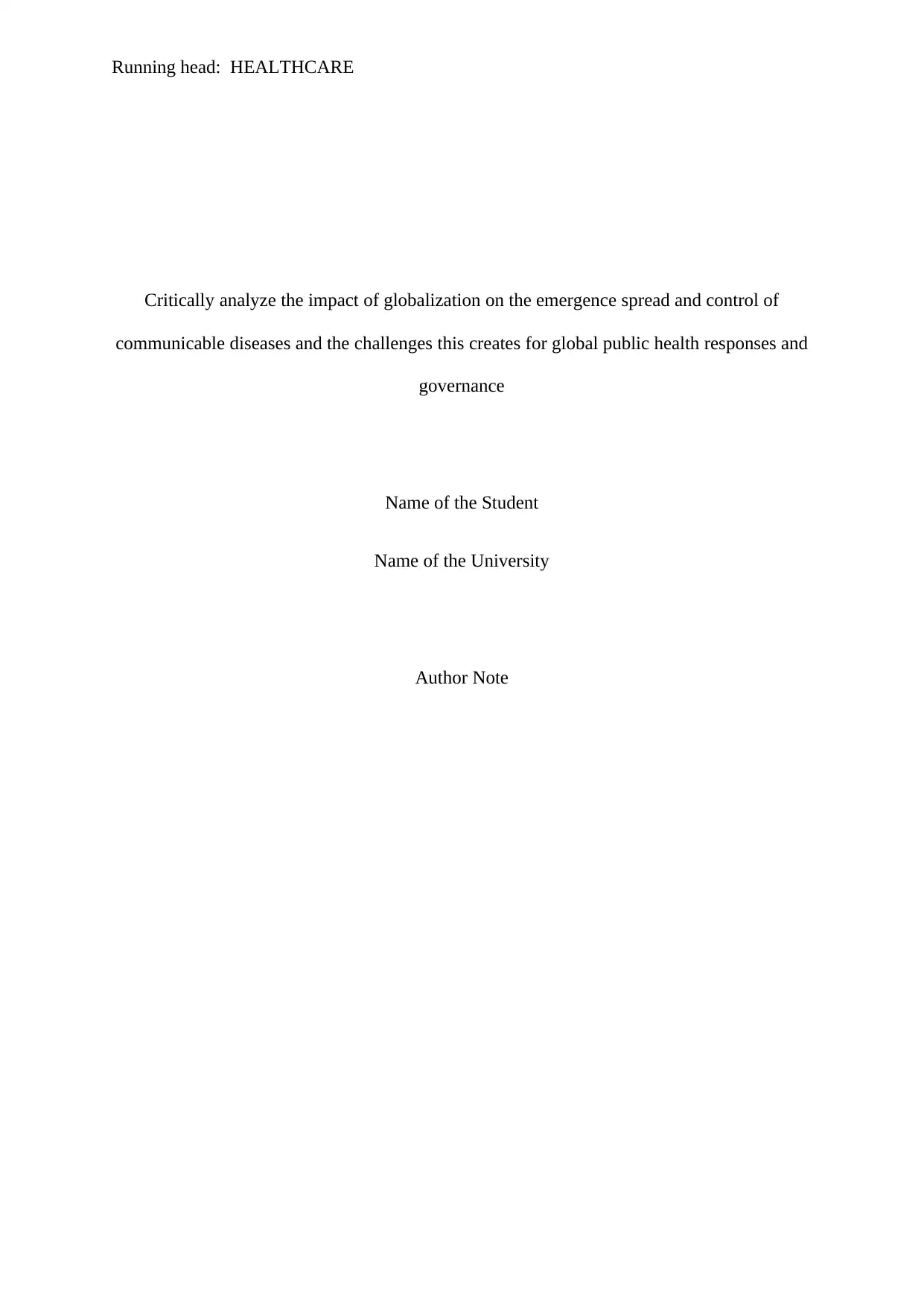
Running head: HEALTHCARE
Critically analyze the impact of globalization on the emergence spread and control of
communicable diseases and the challenges this creates for global public health responses and
governance
Name of the Student
Name of the University
Author Note
Critically analyze the impact of globalization on the emergence spread and control of
communicable diseases and the challenges this creates for global public health responses and
governance
Name of the Student
Name of the University
Author Note
Secure Best Marks with AI Grader
Need help grading? Try our AI Grader for instant feedback on your assignments.
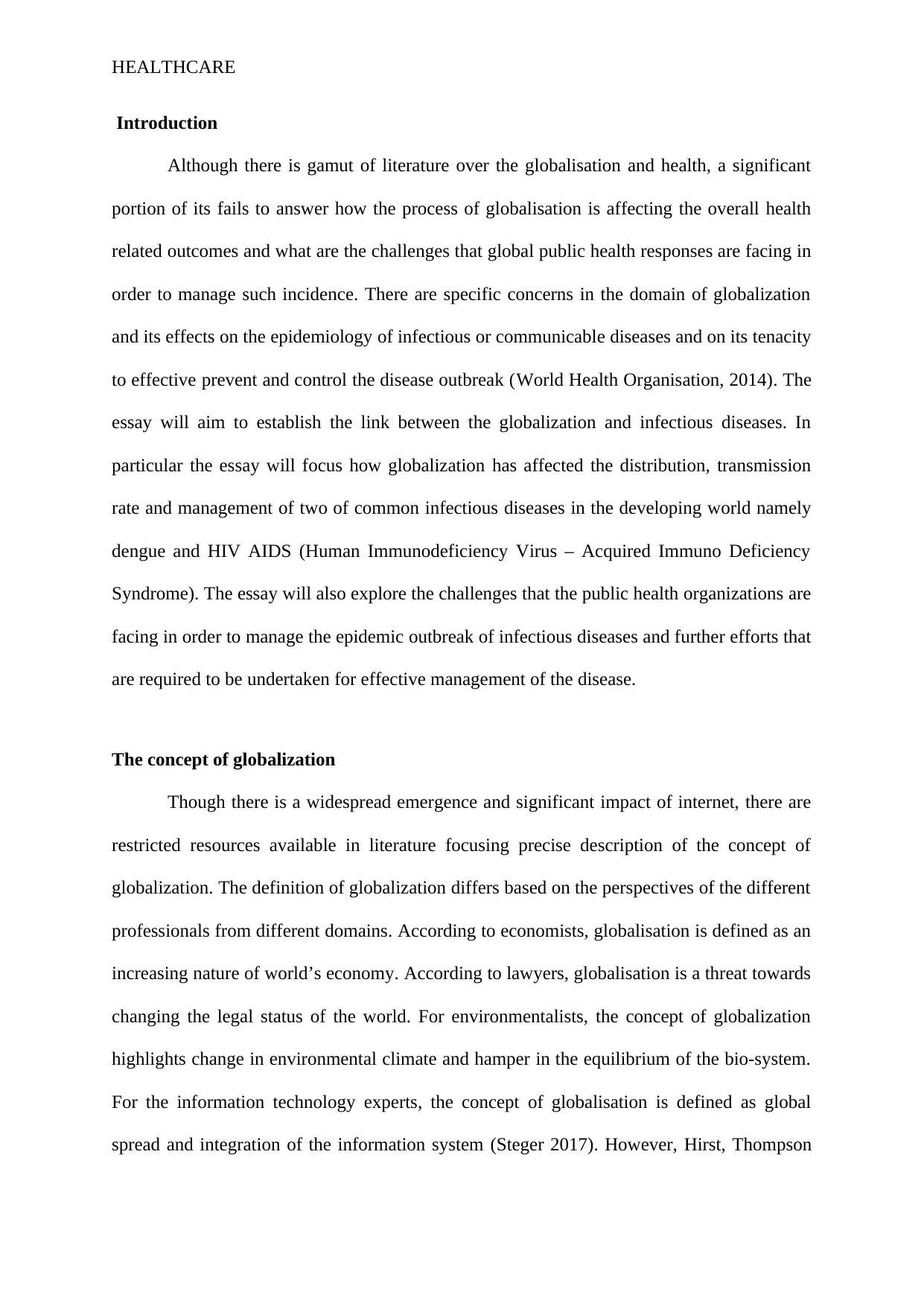
HEALTHCARE
Introduction
Although there is gamut of literature over the globalisation and health, a significant
portion of its fails to answer how the process of globalisation is affecting the overall health
related outcomes and what are the challenges that global public health responses are facing in
order to manage such incidence. There are specific concerns in the domain of globalization
and its effects on the epidemiology of infectious or communicable diseases and on its tenacity
to effective prevent and control the disease outbreak (World Health Organisation, 2014). The
essay will aim to establish the link between the globalization and infectious diseases. In
particular the essay will focus how globalization has affected the distribution, transmission
rate and management of two of common infectious diseases in the developing world namely
dengue and HIV AIDS (Human Immunodeficiency Virus – Acquired Immuno Deficiency
Syndrome). The essay will also explore the challenges that the public health organizations are
facing in order to manage the epidemic outbreak of infectious diseases and further efforts that
are required to be undertaken for effective management of the disease.
The concept of globalization
Though there is a widespread emergence and significant impact of internet, there are
restricted resources available in literature focusing precise description of the concept of
globalization. The definition of globalization differs based on the perspectives of the different
professionals from different domains. According to economists, globalisation is defined as an
increasing nature of world’s economy. According to lawyers, globalisation is a threat towards
changing the legal status of the world. For environmentalists, the concept of globalization
highlights change in environmental climate and hamper in the equilibrium of the bio-system.
For the information technology experts, the concept of globalisation is defined as global
spread and integration of the information system (Steger 2017). However, Hirst, Thompson
Introduction
Although there is gamut of literature over the globalisation and health, a significant
portion of its fails to answer how the process of globalisation is affecting the overall health
related outcomes and what are the challenges that global public health responses are facing in
order to manage such incidence. There are specific concerns in the domain of globalization
and its effects on the epidemiology of infectious or communicable diseases and on its tenacity
to effective prevent and control the disease outbreak (World Health Organisation, 2014). The
essay will aim to establish the link between the globalization and infectious diseases. In
particular the essay will focus how globalization has affected the distribution, transmission
rate and management of two of common infectious diseases in the developing world namely
dengue and HIV AIDS (Human Immunodeficiency Virus – Acquired Immuno Deficiency
Syndrome). The essay will also explore the challenges that the public health organizations are
facing in order to manage the epidemic outbreak of infectious diseases and further efforts that
are required to be undertaken for effective management of the disease.
The concept of globalization
Though there is a widespread emergence and significant impact of internet, there are
restricted resources available in literature focusing precise description of the concept of
globalization. The definition of globalization differs based on the perspectives of the different
professionals from different domains. According to economists, globalisation is defined as an
increasing nature of world’s economy. According to lawyers, globalisation is a threat towards
changing the legal status of the world. For environmentalists, the concept of globalization
highlights change in environmental climate and hamper in the equilibrium of the bio-system.
For the information technology experts, the concept of globalisation is defined as global
spread and integration of the information system (Steger 2017). However, Hirst, Thompson
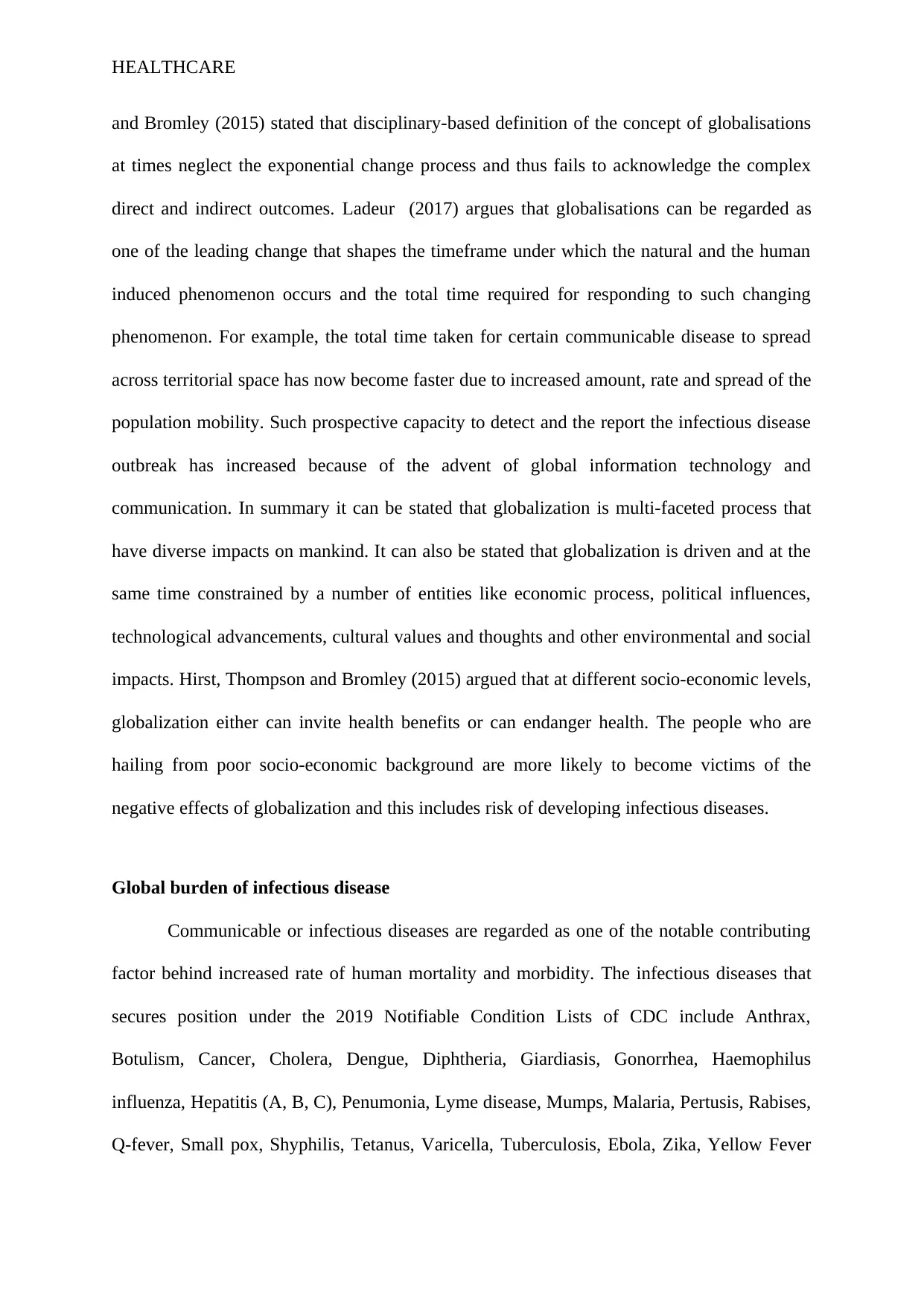
HEALTHCARE
and Bromley (2015) stated that disciplinary-based definition of the concept of globalisations
at times neglect the exponential change process and thus fails to acknowledge the complex
direct and indirect outcomes. Ladeur (2017) argues that globalisations can be regarded as
one of the leading change that shapes the timeframe under which the natural and the human
induced phenomenon occurs and the total time required for responding to such changing
phenomenon. For example, the total time taken for certain communicable disease to spread
across territorial space has now become faster due to increased amount, rate and spread of the
population mobility. Such prospective capacity to detect and the report the infectious disease
outbreak has increased because of the advent of global information technology and
communication. In summary it can be stated that globalization is multi-faceted process that
have diverse impacts on mankind. It can also be stated that globalization is driven and at the
same time constrained by a number of entities like economic process, political influences,
technological advancements, cultural values and thoughts and other environmental and social
impacts. Hirst, Thompson and Bromley (2015) argued that at different socio-economic levels,
globalization either can invite health benefits or can endanger health. The people who are
hailing from poor socio-economic background are more likely to become victims of the
negative effects of globalization and this includes risk of developing infectious diseases.
Global burden of infectious disease
Communicable or infectious diseases are regarded as one of the notable contributing
factor behind increased rate of human mortality and morbidity. The infectious diseases that
secures position under the 2019 Notifiable Condition Lists of CDC include Anthrax,
Botulism, Cancer, Cholera, Dengue, Diphtheria, Giardiasis, Gonorrhea, Haemophilus
influenza, Hepatitis (A, B, C), Penumonia, Lyme disease, Mumps, Malaria, Pertusis, Rabises,
Q-fever, Small pox, Shyphilis, Tetanus, Varicella, Tuberculosis, Ebola, Zika, Yellow Fever
and Bromley (2015) stated that disciplinary-based definition of the concept of globalisations
at times neglect the exponential change process and thus fails to acknowledge the complex
direct and indirect outcomes. Ladeur (2017) argues that globalisations can be regarded as
one of the leading change that shapes the timeframe under which the natural and the human
induced phenomenon occurs and the total time required for responding to such changing
phenomenon. For example, the total time taken for certain communicable disease to spread
across territorial space has now become faster due to increased amount, rate and spread of the
population mobility. Such prospective capacity to detect and the report the infectious disease
outbreak has increased because of the advent of global information technology and
communication. In summary it can be stated that globalization is multi-faceted process that
have diverse impacts on mankind. It can also be stated that globalization is driven and at the
same time constrained by a number of entities like economic process, political influences,
technological advancements, cultural values and thoughts and other environmental and social
impacts. Hirst, Thompson and Bromley (2015) argued that at different socio-economic levels,
globalization either can invite health benefits or can endanger health. The people who are
hailing from poor socio-economic background are more likely to become victims of the
negative effects of globalization and this includes risk of developing infectious diseases.
Global burden of infectious disease
Communicable or infectious diseases are regarded as one of the notable contributing
factor behind increased rate of human mortality and morbidity. The infectious diseases that
secures position under the 2019 Notifiable Condition Lists of CDC include Anthrax,
Botulism, Cancer, Cholera, Dengue, Diphtheria, Giardiasis, Gonorrhea, Haemophilus
influenza, Hepatitis (A, B, C), Penumonia, Lyme disease, Mumps, Malaria, Pertusis, Rabises,
Q-fever, Small pox, Shyphilis, Tetanus, Varicella, Tuberculosis, Ebola, Zika, Yellow Fever
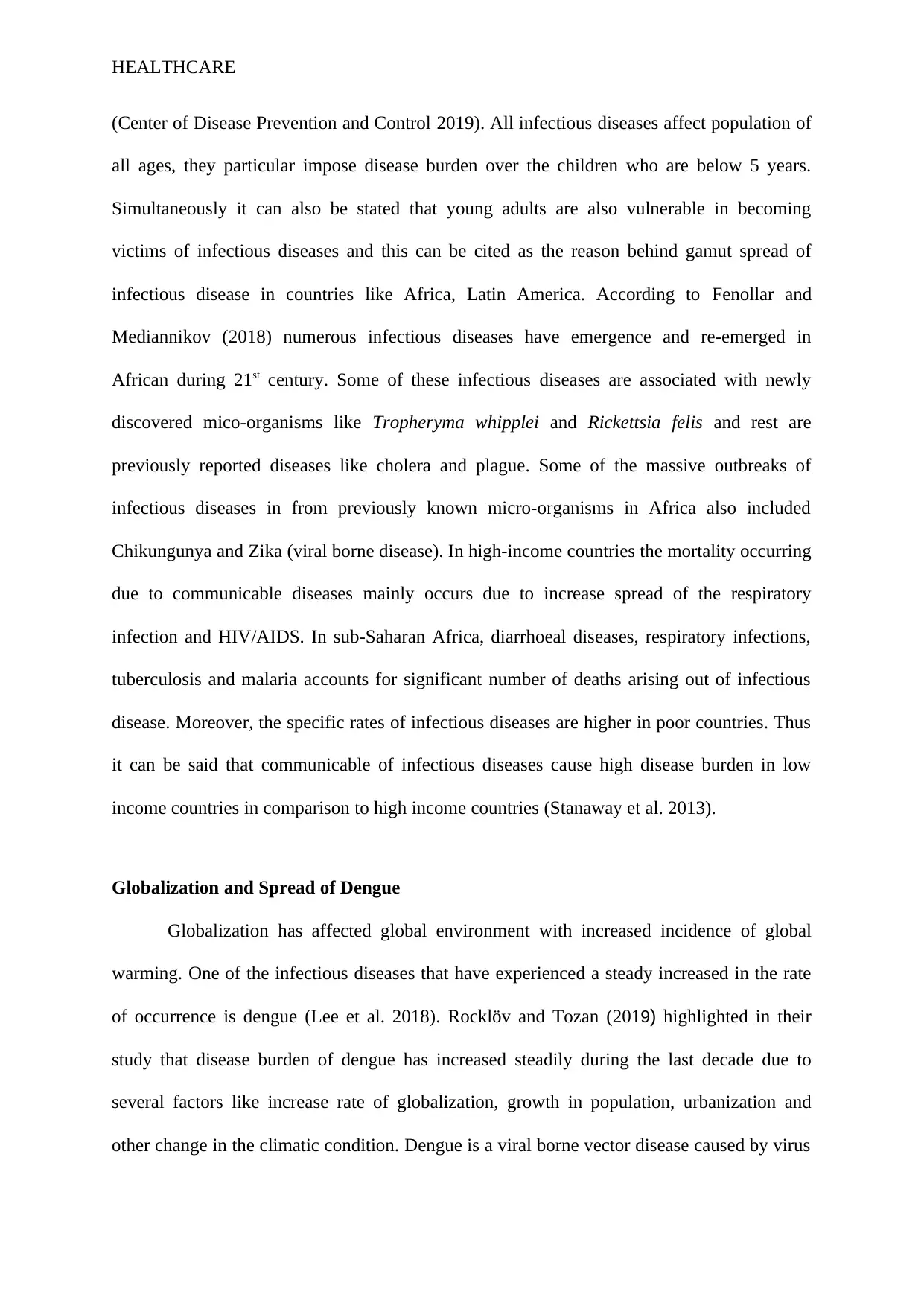
HEALTHCARE
(Center of Disease Prevention and Control 2019). All infectious diseases affect population of
all ages, they particular impose disease burden over the children who are below 5 years.
Simultaneously it can also be stated that young adults are also vulnerable in becoming
victims of infectious diseases and this can be cited as the reason behind gamut spread of
infectious disease in countries like Africa, Latin America. According to Fenollar and
Mediannikov (2018) numerous infectious diseases have emergence and re-emerged in
African during 21st century. Some of these infectious diseases are associated with newly
discovered mico-organisms like Tropheryma whipplei and Rickettsia felis and rest are
previously reported diseases like cholera and plague. Some of the massive outbreaks of
infectious diseases in from previously known micro-organisms in Africa also included
Chikungunya and Zika (viral borne disease). In high-income countries the mortality occurring
due to communicable diseases mainly occurs due to increase spread of the respiratory
infection and HIV/AIDS. In sub-Saharan Africa, diarrhoeal diseases, respiratory infections,
tuberculosis and malaria accounts for significant number of deaths arising out of infectious
disease. Moreover, the specific rates of infectious diseases are higher in poor countries. Thus
it can be said that communicable of infectious diseases cause high disease burden in low
income countries in comparison to high income countries (Stanaway et al. 2013).
Globalization and Spread of Dengue
Globalization has affected global environment with increased incidence of global
warming. One of the infectious diseases that have experienced a steady increased in the rate
of occurrence is dengue (Lee et al. 2018). Rocklöv and Tozan (2019) highlighted in their
study that disease burden of dengue has increased steadily during the last decade due to
several factors like increase rate of globalization, growth in population, urbanization and
other change in the climatic condition. Dengue is a viral borne vector disease caused by virus
(Center of Disease Prevention and Control 2019). All infectious diseases affect population of
all ages, they particular impose disease burden over the children who are below 5 years.
Simultaneously it can also be stated that young adults are also vulnerable in becoming
victims of infectious diseases and this can be cited as the reason behind gamut spread of
infectious disease in countries like Africa, Latin America. According to Fenollar and
Mediannikov (2018) numerous infectious diseases have emergence and re-emerged in
African during 21st century. Some of these infectious diseases are associated with newly
discovered mico-organisms like Tropheryma whipplei and Rickettsia felis and rest are
previously reported diseases like cholera and plague. Some of the massive outbreaks of
infectious diseases in from previously known micro-organisms in Africa also included
Chikungunya and Zika (viral borne disease). In high-income countries the mortality occurring
due to communicable diseases mainly occurs due to increase spread of the respiratory
infection and HIV/AIDS. In sub-Saharan Africa, diarrhoeal diseases, respiratory infections,
tuberculosis and malaria accounts for significant number of deaths arising out of infectious
disease. Moreover, the specific rates of infectious diseases are higher in poor countries. Thus
it can be said that communicable of infectious diseases cause high disease burden in low
income countries in comparison to high income countries (Stanaway et al. 2013).
Globalization and Spread of Dengue
Globalization has affected global environment with increased incidence of global
warming. One of the infectious diseases that have experienced a steady increased in the rate
of occurrence is dengue (Lee et al. 2018). Rocklöv and Tozan (2019) highlighted in their
study that disease burden of dengue has increased steadily during the last decade due to
several factors like increase rate of globalization, growth in population, urbanization and
other change in the climatic condition. Dengue is a viral borne vector disease caused by virus
Secure Best Marks with AI Grader
Need help grading? Try our AI Grader for instant feedback on your assignments.
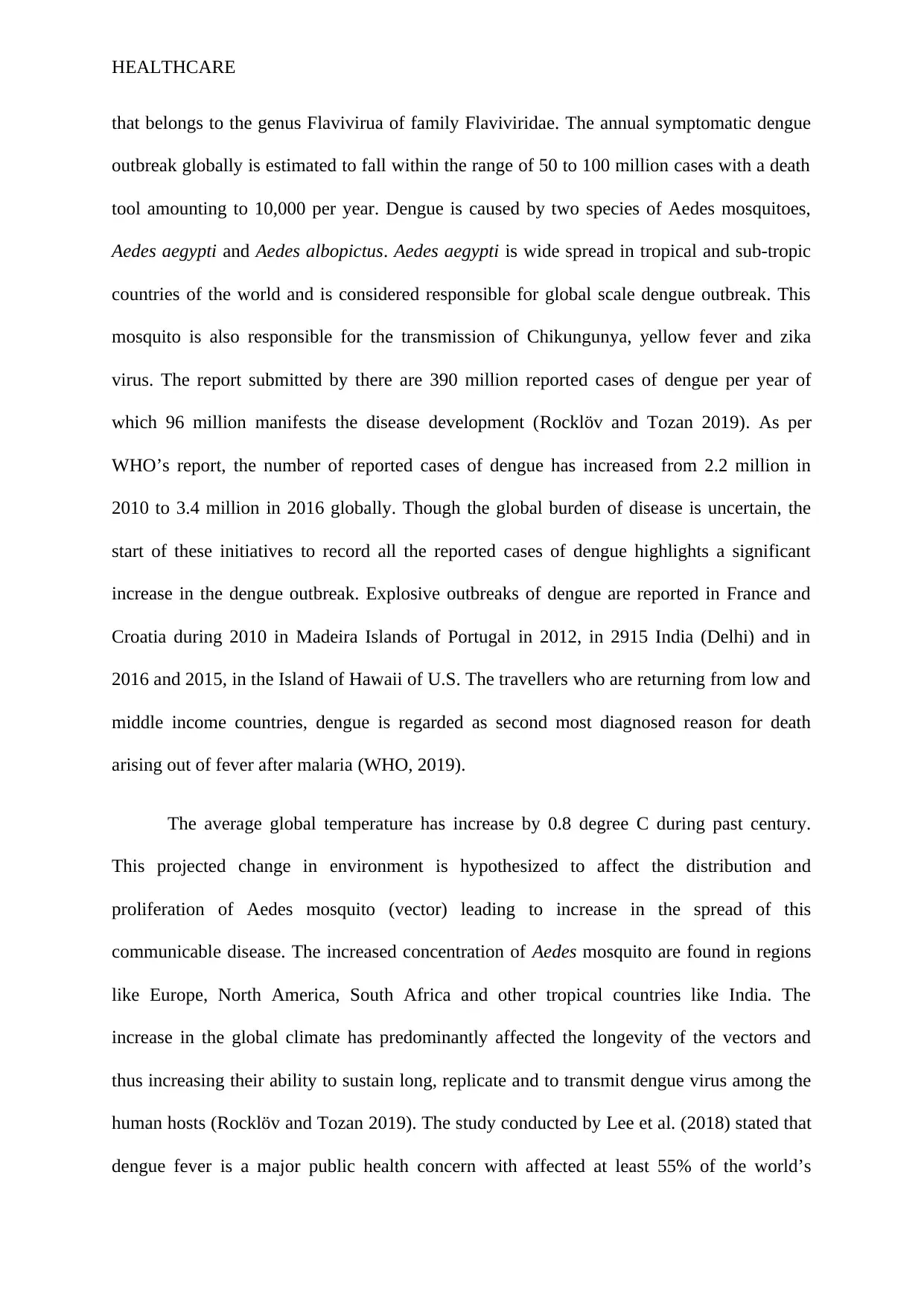
HEALTHCARE
that belongs to the genus Flavivirua of family Flaviviridae. The annual symptomatic dengue
outbreak globally is estimated to fall within the range of 50 to 100 million cases with a death
tool amounting to 10,000 per year. Dengue is caused by two species of Aedes mosquitoes,
Aedes aegypti and Aedes albopictus. Aedes aegypti is wide spread in tropical and sub-tropic
countries of the world and is considered responsible for global scale dengue outbreak. This
mosquito is also responsible for the transmission of Chikungunya, yellow fever and zika
virus. The report submitted by there are 390 million reported cases of dengue per year of
which 96 million manifests the disease development (Rocklöv and Tozan 2019). As per
WHO’s report, the number of reported cases of dengue has increased from 2.2 million in
2010 to 3.4 million in 2016 globally. Though the global burden of disease is uncertain, the
start of these initiatives to record all the reported cases of dengue highlights a significant
increase in the dengue outbreak. Explosive outbreaks of dengue are reported in France and
Croatia during 2010 in Madeira Islands of Portugal in 2012, in 2915 India (Delhi) and in
2016 and 2015, in the Island of Hawaii of U.S. The travellers who are returning from low and
middle income countries, dengue is regarded as second most diagnosed reason for death
arising out of fever after malaria (WHO, 2019).
The average global temperature has increase by 0.8 degree C during past century.
This projected change in environment is hypothesized to affect the distribution and
proliferation of Aedes mosquito (vector) leading to increase in the spread of this
communicable disease. The increased concentration of Aedes mosquito are found in regions
like Europe, North America, South Africa and other tropical countries like India. The
increase in the global climate has predominantly affected the longevity of the vectors and
thus increasing their ability to sustain long, replicate and to transmit dengue virus among the
human hosts (Rocklöv and Tozan 2019). The study conducted by Lee et al. (2018) stated that
dengue fever is a major public health concern with affected at least 55% of the world’s
that belongs to the genus Flavivirua of family Flaviviridae. The annual symptomatic dengue
outbreak globally is estimated to fall within the range of 50 to 100 million cases with a death
tool amounting to 10,000 per year. Dengue is caused by two species of Aedes mosquitoes,
Aedes aegypti and Aedes albopictus. Aedes aegypti is wide spread in tropical and sub-tropic
countries of the world and is considered responsible for global scale dengue outbreak. This
mosquito is also responsible for the transmission of Chikungunya, yellow fever and zika
virus. The report submitted by there are 390 million reported cases of dengue per year of
which 96 million manifests the disease development (Rocklöv and Tozan 2019). As per
WHO’s report, the number of reported cases of dengue has increased from 2.2 million in
2010 to 3.4 million in 2016 globally. Though the global burden of disease is uncertain, the
start of these initiatives to record all the reported cases of dengue highlights a significant
increase in the dengue outbreak. Explosive outbreaks of dengue are reported in France and
Croatia during 2010 in Madeira Islands of Portugal in 2012, in 2915 India (Delhi) and in
2016 and 2015, in the Island of Hawaii of U.S. The travellers who are returning from low and
middle income countries, dengue is regarded as second most diagnosed reason for death
arising out of fever after malaria (WHO, 2019).
The average global temperature has increase by 0.8 degree C during past century.
This projected change in environment is hypothesized to affect the distribution and
proliferation of Aedes mosquito (vector) leading to increase in the spread of this
communicable disease. The increased concentration of Aedes mosquito are found in regions
like Europe, North America, South Africa and other tropical countries like India. The
increase in the global climate has predominantly affected the longevity of the vectors and
thus increasing their ability to sustain long, replicate and to transmit dengue virus among the
human hosts (Rocklöv and Tozan 2019). The study conducted by Lee et al. (2018) stated that
dengue fever is a major public health concern with affected at least 55% of the world’s
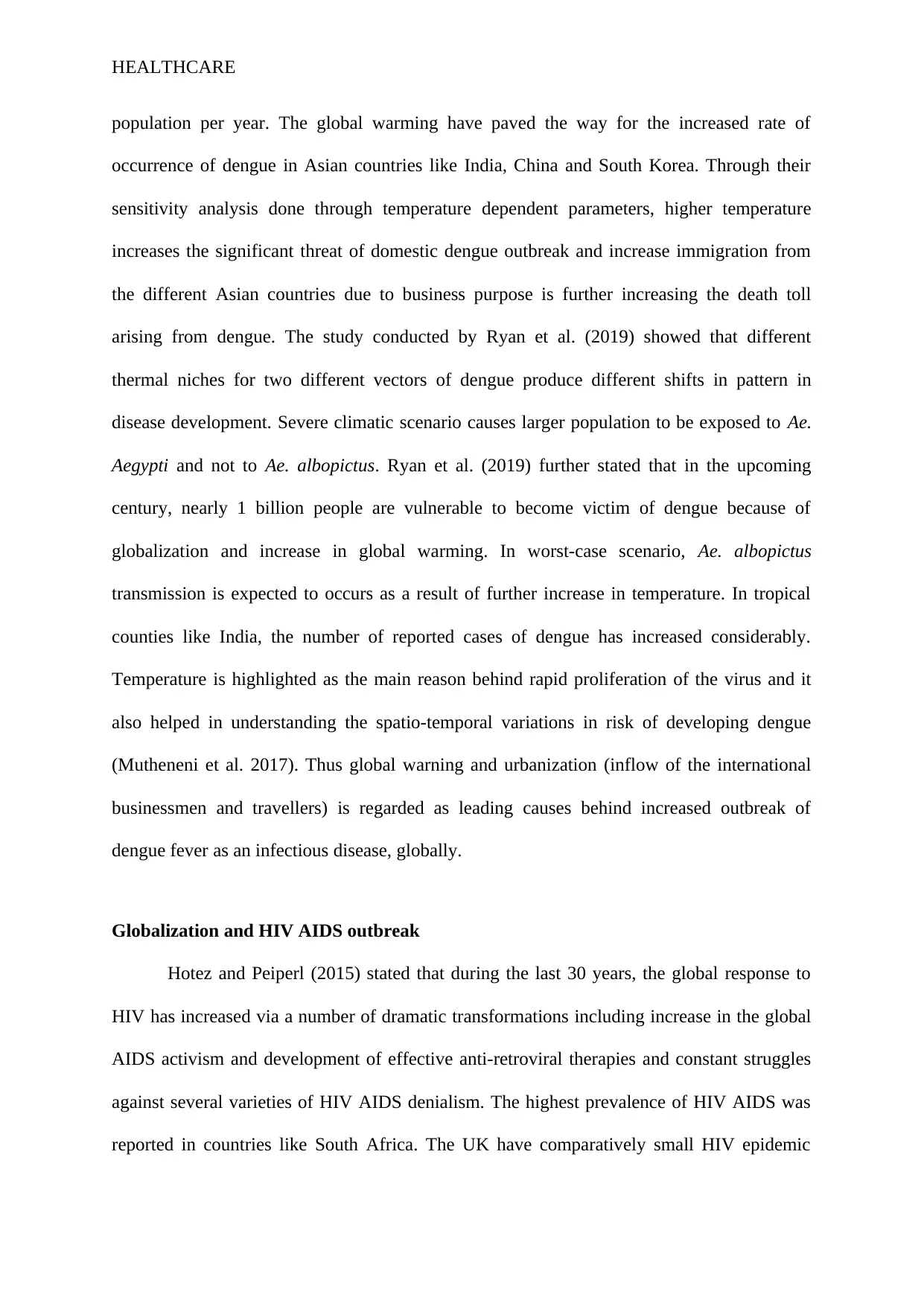
HEALTHCARE
population per year. The global warming have paved the way for the increased rate of
occurrence of dengue in Asian countries like India, China and South Korea. Through their
sensitivity analysis done through temperature dependent parameters, higher temperature
increases the significant threat of domestic dengue outbreak and increase immigration from
the different Asian countries due to business purpose is further increasing the death toll
arising from dengue. The study conducted by Ryan et al. (2019) showed that different
thermal niches for two different vectors of dengue produce different shifts in pattern in
disease development. Severe climatic scenario causes larger population to be exposed to Ae.
Aegypti and not to Ae. albopictus. Ryan et al. (2019) further stated that in the upcoming
century, nearly 1 billion people are vulnerable to become victim of dengue because of
globalization and increase in global warming. In worst-case scenario, Ae. albopictus
transmission is expected to occurs as a result of further increase in temperature. In tropical
counties like India, the number of reported cases of dengue has increased considerably.
Temperature is highlighted as the main reason behind rapid proliferation of the virus and it
also helped in understanding the spatio-temporal variations in risk of developing dengue
(Mutheneni et al. 2017). Thus global warning and urbanization (inflow of the international
businessmen and travellers) is regarded as leading causes behind increased outbreak of
dengue fever as an infectious disease, globally.
Globalization and HIV AIDS outbreak
Hotez and Peiperl (2015) stated that during the last 30 years, the global response to
HIV has increased via a number of dramatic transformations including increase in the global
AIDS activism and development of effective anti-retroviral therapies and constant struggles
against several varieties of HIV AIDS denialism. The highest prevalence of HIV AIDS was
reported in countries like South Africa. The UK have comparatively small HIV epidemic
population per year. The global warming have paved the way for the increased rate of
occurrence of dengue in Asian countries like India, China and South Korea. Through their
sensitivity analysis done through temperature dependent parameters, higher temperature
increases the significant threat of domestic dengue outbreak and increase immigration from
the different Asian countries due to business purpose is further increasing the death toll
arising from dengue. The study conducted by Ryan et al. (2019) showed that different
thermal niches for two different vectors of dengue produce different shifts in pattern in
disease development. Severe climatic scenario causes larger population to be exposed to Ae.
Aegypti and not to Ae. albopictus. Ryan et al. (2019) further stated that in the upcoming
century, nearly 1 billion people are vulnerable to become victim of dengue because of
globalization and increase in global warming. In worst-case scenario, Ae. albopictus
transmission is expected to occurs as a result of further increase in temperature. In tropical
counties like India, the number of reported cases of dengue has increased considerably.
Temperature is highlighted as the main reason behind rapid proliferation of the virus and it
also helped in understanding the spatio-temporal variations in risk of developing dengue
(Mutheneni et al. 2017). Thus global warning and urbanization (inflow of the international
businessmen and travellers) is regarded as leading causes behind increased outbreak of
dengue fever as an infectious disease, globally.
Globalization and HIV AIDS outbreak
Hotez and Peiperl (2015) stated that during the last 30 years, the global response to
HIV has increased via a number of dramatic transformations including increase in the global
AIDS activism and development of effective anti-retroviral therapies and constant struggles
against several varieties of HIV AIDS denialism. The highest prevalence of HIV AIDS was
reported in countries like South Africa. The UK have comparatively small HIV epidemic
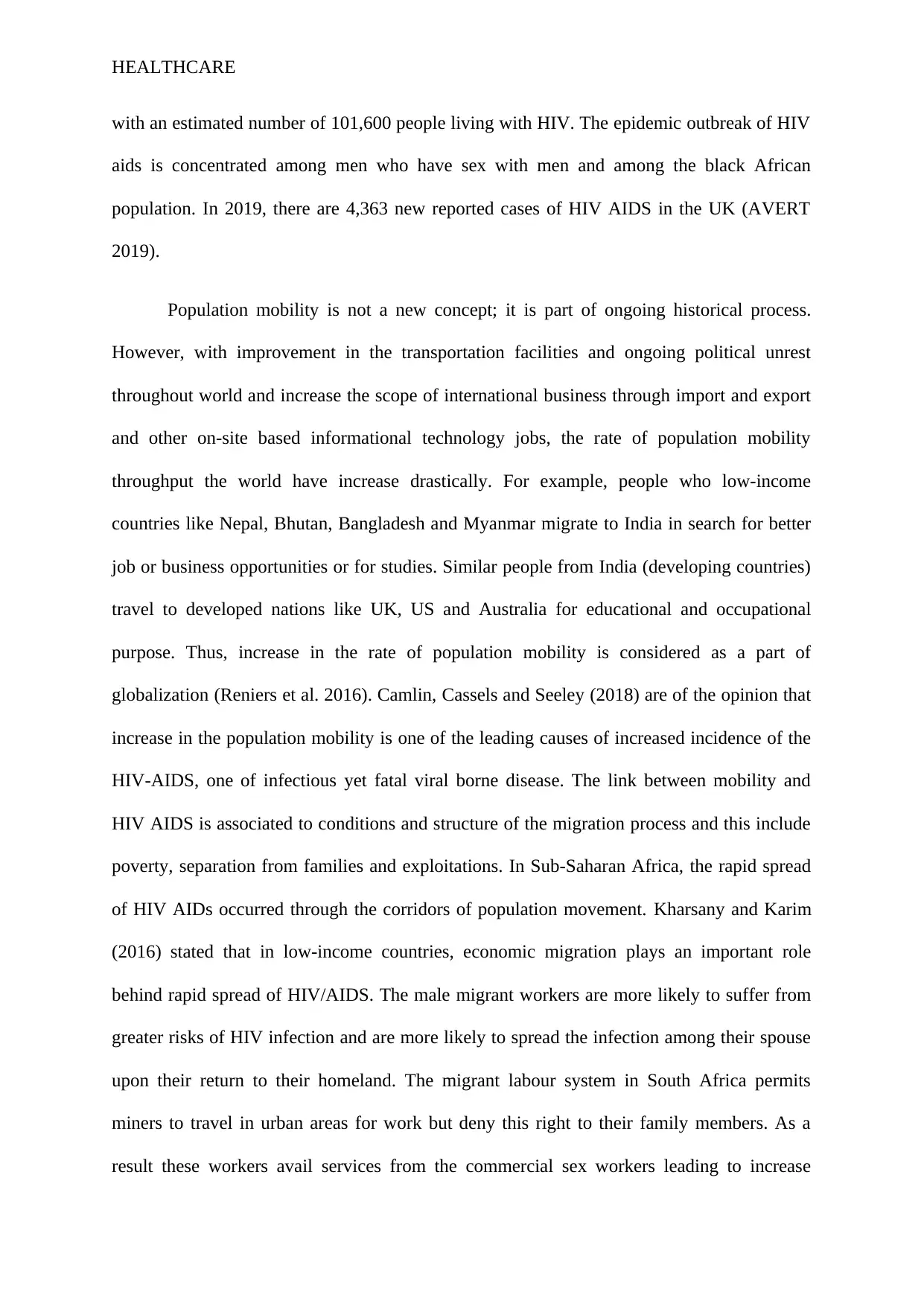
HEALTHCARE
with an estimated number of 101,600 people living with HIV. The epidemic outbreak of HIV
aids is concentrated among men who have sex with men and among the black African
population. In 2019, there are 4,363 new reported cases of HIV AIDS in the UK (AVERT
2019).
Population mobility is not a new concept; it is part of ongoing historical process.
However, with improvement in the transportation facilities and ongoing political unrest
throughout world and increase the scope of international business through import and export
and other on-site based informational technology jobs, the rate of population mobility
throughput the world have increase drastically. For example, people who low-income
countries like Nepal, Bhutan, Bangladesh and Myanmar migrate to India in search for better
job or business opportunities or for studies. Similar people from India (developing countries)
travel to developed nations like UK, US and Australia for educational and occupational
purpose. Thus, increase in the rate of population mobility is considered as a part of
globalization (Reniers et al. 2016). Camlin, Cassels and Seeley (2018) are of the opinion that
increase in the population mobility is one of the leading causes of increased incidence of the
HIV-AIDS, one of infectious yet fatal viral borne disease. The link between mobility and
HIV AIDS is associated to conditions and structure of the migration process and this include
poverty, separation from families and exploitations. In Sub-Saharan Africa, the rapid spread
of HIV AIDs occurred through the corridors of population movement. Kharsany and Karim
(2016) stated that in low-income countries, economic migration plays an important role
behind rapid spread of HIV/AIDS. The male migrant workers are more likely to suffer from
greater risks of HIV infection and are more likely to spread the infection among their spouse
upon their return to their homeland. The migrant labour system in South Africa permits
miners to travel in urban areas for work but deny this right to their family members. As a
result these workers avail services from the commercial sex workers leading to increase
with an estimated number of 101,600 people living with HIV. The epidemic outbreak of HIV
aids is concentrated among men who have sex with men and among the black African
population. In 2019, there are 4,363 new reported cases of HIV AIDS in the UK (AVERT
2019).
Population mobility is not a new concept; it is part of ongoing historical process.
However, with improvement in the transportation facilities and ongoing political unrest
throughout world and increase the scope of international business through import and export
and other on-site based informational technology jobs, the rate of population mobility
throughput the world have increase drastically. For example, people who low-income
countries like Nepal, Bhutan, Bangladesh and Myanmar migrate to India in search for better
job or business opportunities or for studies. Similar people from India (developing countries)
travel to developed nations like UK, US and Australia for educational and occupational
purpose. Thus, increase in the rate of population mobility is considered as a part of
globalization (Reniers et al. 2016). Camlin, Cassels and Seeley (2018) are of the opinion that
increase in the population mobility is one of the leading causes of increased incidence of the
HIV-AIDS, one of infectious yet fatal viral borne disease. The link between mobility and
HIV AIDS is associated to conditions and structure of the migration process and this include
poverty, separation from families and exploitations. In Sub-Saharan Africa, the rapid spread
of HIV AIDs occurred through the corridors of population movement. Kharsany and Karim
(2016) stated that in low-income countries, economic migration plays an important role
behind rapid spread of HIV/AIDS. The male migrant workers are more likely to suffer from
greater risks of HIV infection and are more likely to spread the infection among their spouse
upon their return to their homeland. The migrant labour system in South Africa permits
miners to travel in urban areas for work but deny this right to their family members. As a
result these workers avail services from the commercial sex workers leading to increase
Paraphrase This Document
Need a fresh take? Get an instant paraphrase of this document with our AI Paraphraser
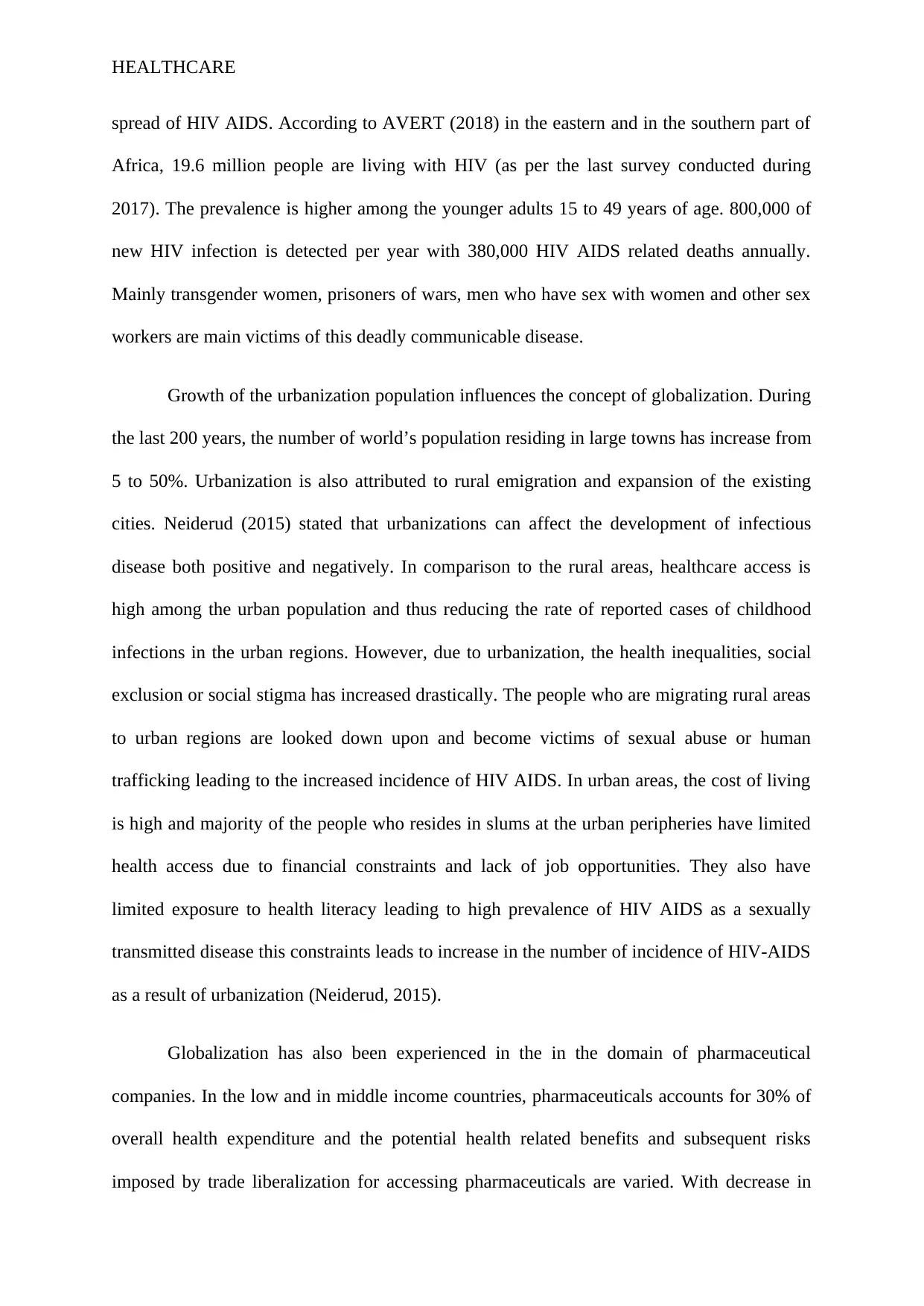
HEALTHCARE
spread of HIV AIDS. According to AVERT (2018) in the eastern and in the southern part of
Africa, 19.6 million people are living with HIV (as per the last survey conducted during
2017). The prevalence is higher among the younger adults 15 to 49 years of age. 800,000 of
new HIV infection is detected per year with 380,000 HIV AIDS related deaths annually.
Mainly transgender women, prisoners of wars, men who have sex with women and other sex
workers are main victims of this deadly communicable disease.
Growth of the urbanization population influences the concept of globalization. During
the last 200 years, the number of world’s population residing in large towns has increase from
5 to 50%. Urbanization is also attributed to rural emigration and expansion of the existing
cities. Neiderud (2015) stated that urbanizations can affect the development of infectious
disease both positive and negatively. In comparison to the rural areas, healthcare access is
high among the urban population and thus reducing the rate of reported cases of childhood
infections in the urban regions. However, due to urbanization, the health inequalities, social
exclusion or social stigma has increased drastically. The people who are migrating rural areas
to urban regions are looked down upon and become victims of sexual abuse or human
trafficking leading to the increased incidence of HIV AIDS. In urban areas, the cost of living
is high and majority of the people who resides in slums at the urban peripheries have limited
health access due to financial constraints and lack of job opportunities. They also have
limited exposure to health literacy leading to high prevalence of HIV AIDS as a sexually
transmitted disease this constraints leads to increase in the number of incidence of HIV-AIDS
as a result of urbanization (Neiderud, 2015).
Globalization has also been experienced in the in the domain of pharmaceutical
companies. In the low and in middle income countries, pharmaceuticals accounts for 30% of
overall health expenditure and the potential health related benefits and subsequent risks
imposed by trade liberalization for accessing pharmaceuticals are varied. With decrease in
spread of HIV AIDS. According to AVERT (2018) in the eastern and in the southern part of
Africa, 19.6 million people are living with HIV (as per the last survey conducted during
2017). The prevalence is higher among the younger adults 15 to 49 years of age. 800,000 of
new HIV infection is detected per year with 380,000 HIV AIDS related deaths annually.
Mainly transgender women, prisoners of wars, men who have sex with women and other sex
workers are main victims of this deadly communicable disease.
Growth of the urbanization population influences the concept of globalization. During
the last 200 years, the number of world’s population residing in large towns has increase from
5 to 50%. Urbanization is also attributed to rural emigration and expansion of the existing
cities. Neiderud (2015) stated that urbanizations can affect the development of infectious
disease both positive and negatively. In comparison to the rural areas, healthcare access is
high among the urban population and thus reducing the rate of reported cases of childhood
infections in the urban regions. However, due to urbanization, the health inequalities, social
exclusion or social stigma has increased drastically. The people who are migrating rural areas
to urban regions are looked down upon and become victims of sexual abuse or human
trafficking leading to the increased incidence of HIV AIDS. In urban areas, the cost of living
is high and majority of the people who resides in slums at the urban peripheries have limited
health access due to financial constraints and lack of job opportunities. They also have
limited exposure to health literacy leading to high prevalence of HIV AIDS as a sexually
transmitted disease this constraints leads to increase in the number of incidence of HIV-AIDS
as a result of urbanization (Neiderud, 2015).
Globalization has also been experienced in the in the domain of pharmaceutical
companies. In the low and in middle income countries, pharmaceuticals accounts for 30% of
overall health expenditure and the potential health related benefits and subsequent risks
imposed by trade liberalization for accessing pharmaceuticals are varied. With decrease in
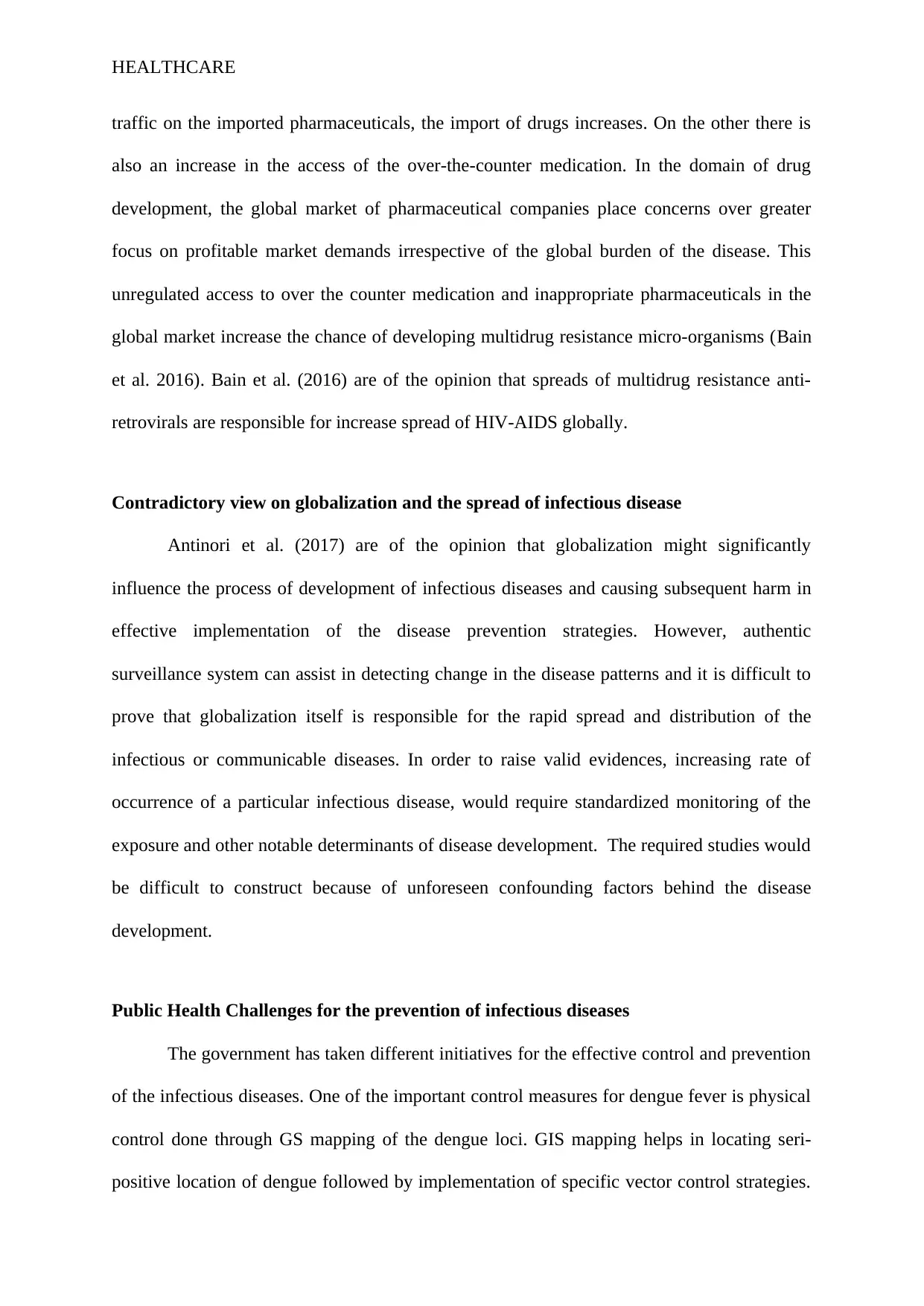
HEALTHCARE
traffic on the imported pharmaceuticals, the import of drugs increases. On the other there is
also an increase in the access of the over-the-counter medication. In the domain of drug
development, the global market of pharmaceutical companies place concerns over greater
focus on profitable market demands irrespective of the global burden of the disease. This
unregulated access to over the counter medication and inappropriate pharmaceuticals in the
global market increase the chance of developing multidrug resistance micro-organisms (Bain
et al. 2016). Bain et al. (2016) are of the opinion that spreads of multidrug resistance anti-
retrovirals are responsible for increase spread of HIV-AIDS globally.
Contradictory view on globalization and the spread of infectious disease
Antinori et al. (2017) are of the opinion that globalization might significantly
influence the process of development of infectious diseases and causing subsequent harm in
effective implementation of the disease prevention strategies. However, authentic
surveillance system can assist in detecting change in the disease patterns and it is difficult to
prove that globalization itself is responsible for the rapid spread and distribution of the
infectious or communicable diseases. In order to raise valid evidences, increasing rate of
occurrence of a particular infectious disease, would require standardized monitoring of the
exposure and other notable determinants of disease development. The required studies would
be difficult to construct because of unforeseen confounding factors behind the disease
development.
Public Health Challenges for the prevention of infectious diseases
The government has taken different initiatives for the effective control and prevention
of the infectious diseases. One of the important control measures for dengue fever is physical
control done through GS mapping of the dengue loci. GIS mapping helps in locating seri-
positive location of dengue followed by implementation of specific vector control strategies.
traffic on the imported pharmaceuticals, the import of drugs increases. On the other there is
also an increase in the access of the over-the-counter medication. In the domain of drug
development, the global market of pharmaceutical companies place concerns over greater
focus on profitable market demands irrespective of the global burden of the disease. This
unregulated access to over the counter medication and inappropriate pharmaceuticals in the
global market increase the chance of developing multidrug resistance micro-organisms (Bain
et al. 2016). Bain et al. (2016) are of the opinion that spreads of multidrug resistance anti-
retrovirals are responsible for increase spread of HIV-AIDS globally.
Contradictory view on globalization and the spread of infectious disease
Antinori et al. (2017) are of the opinion that globalization might significantly
influence the process of development of infectious diseases and causing subsequent harm in
effective implementation of the disease prevention strategies. However, authentic
surveillance system can assist in detecting change in the disease patterns and it is difficult to
prove that globalization itself is responsible for the rapid spread and distribution of the
infectious or communicable diseases. In order to raise valid evidences, increasing rate of
occurrence of a particular infectious disease, would require standardized monitoring of the
exposure and other notable determinants of disease development. The required studies would
be difficult to construct because of unforeseen confounding factors behind the disease
development.
Public Health Challenges for the prevention of infectious diseases
The government has taken different initiatives for the effective control and prevention
of the infectious diseases. One of the important control measures for dengue fever is physical
control done through GS mapping of the dengue loci. GIS mapping helps in locating seri-
positive location of dengue followed by implementation of specific vector control strategies.
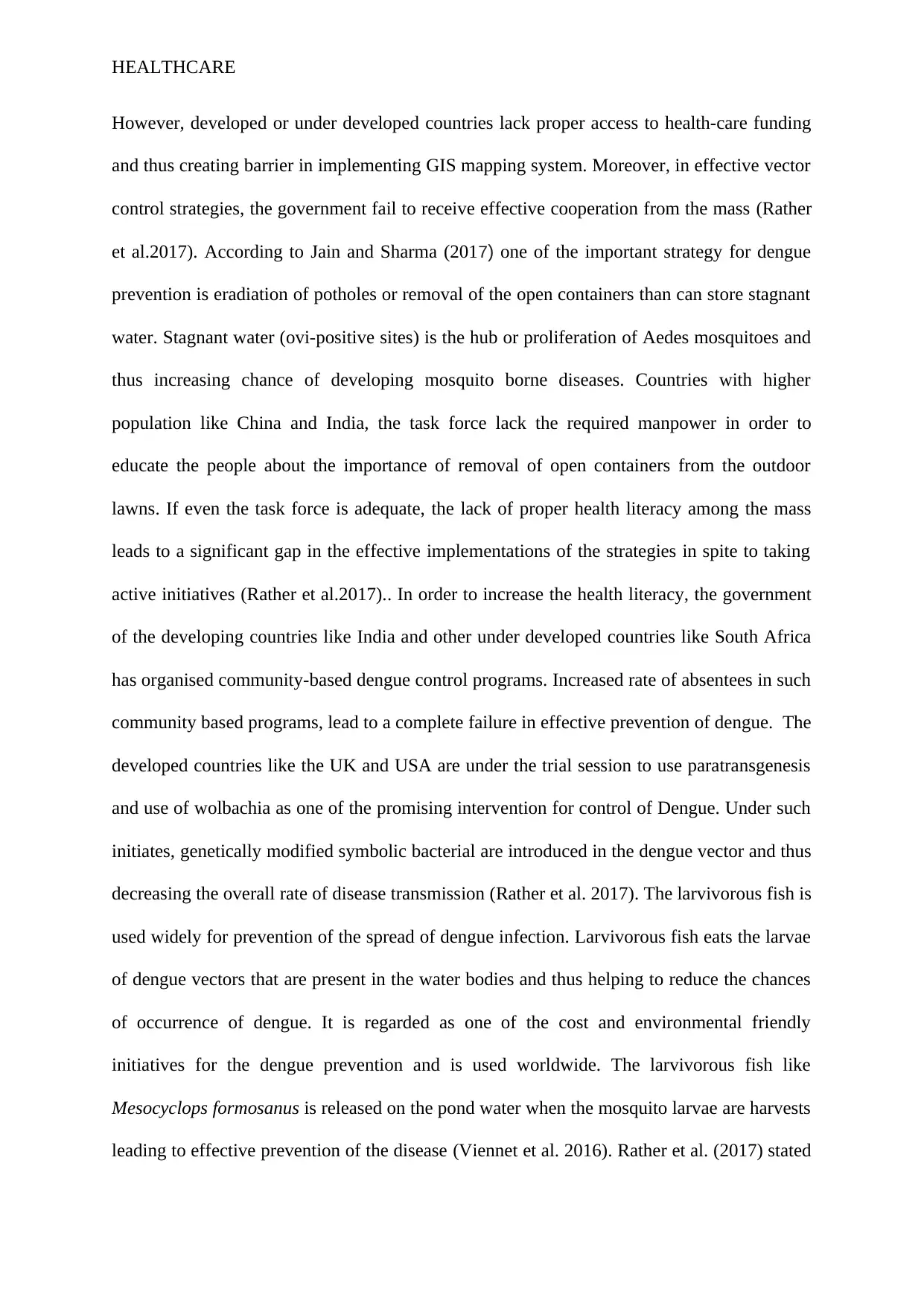
HEALTHCARE
However, developed or under developed countries lack proper access to health-care funding
and thus creating barrier in implementing GIS mapping system. Moreover, in effective vector
control strategies, the government fail to receive effective cooperation from the mass (Rather
et al.2017). According to Jain and Sharma (2017) one of the important strategy for dengue
prevention is eradiation of potholes or removal of the open containers than can store stagnant
water. Stagnant water (ovi-positive sites) is the hub or proliferation of Aedes mosquitoes and
thus increasing chance of developing mosquito borne diseases. Countries with higher
population like China and India, the task force lack the required manpower in order to
educate the people about the importance of removal of open containers from the outdoor
lawns. If even the task force is adequate, the lack of proper health literacy among the mass
leads to a significant gap in the effective implementations of the strategies in spite to taking
active initiatives (Rather et al.2017).. In order to increase the health literacy, the government
of the developing countries like India and other under developed countries like South Africa
has organised community-based dengue control programs. Increased rate of absentees in such
community based programs, lead to a complete failure in effective prevention of dengue. The
developed countries like the UK and USA are under the trial session to use paratransgenesis
and use of wolbachia as one of the promising intervention for control of Dengue. Under such
initiates, genetically modified symbolic bacterial are introduced in the dengue vector and thus
decreasing the overall rate of disease transmission (Rather et al. 2017). The larvivorous fish is
used widely for prevention of the spread of dengue infection. Larvivorous fish eats the larvae
of dengue vectors that are present in the water bodies and thus helping to reduce the chances
of occurrence of dengue. It is regarded as one of the cost and environmental friendly
initiatives for the dengue prevention and is used worldwide. The larvivorous fish like
Mesocyclops formosanus is released on the pond water when the mosquito larvae are harvests
leading to effective prevention of the disease (Viennet et al. 2016). Rather et al. (2017) stated
However, developed or under developed countries lack proper access to health-care funding
and thus creating barrier in implementing GIS mapping system. Moreover, in effective vector
control strategies, the government fail to receive effective cooperation from the mass (Rather
et al.2017). According to Jain and Sharma (2017) one of the important strategy for dengue
prevention is eradiation of potholes or removal of the open containers than can store stagnant
water. Stagnant water (ovi-positive sites) is the hub or proliferation of Aedes mosquitoes and
thus increasing chance of developing mosquito borne diseases. Countries with higher
population like China and India, the task force lack the required manpower in order to
educate the people about the importance of removal of open containers from the outdoor
lawns. If even the task force is adequate, the lack of proper health literacy among the mass
leads to a significant gap in the effective implementations of the strategies in spite to taking
active initiatives (Rather et al.2017).. In order to increase the health literacy, the government
of the developing countries like India and other under developed countries like South Africa
has organised community-based dengue control programs. Increased rate of absentees in such
community based programs, lead to a complete failure in effective prevention of dengue. The
developed countries like the UK and USA are under the trial session to use paratransgenesis
and use of wolbachia as one of the promising intervention for control of Dengue. Under such
initiates, genetically modified symbolic bacterial are introduced in the dengue vector and thus
decreasing the overall rate of disease transmission (Rather et al. 2017). The larvivorous fish is
used widely for prevention of the spread of dengue infection. Larvivorous fish eats the larvae
of dengue vectors that are present in the water bodies and thus helping to reduce the chances
of occurrence of dengue. It is regarded as one of the cost and environmental friendly
initiatives for the dengue prevention and is used worldwide. The larvivorous fish like
Mesocyclops formosanus is released on the pond water when the mosquito larvae are harvests
leading to effective prevention of the disease (Viennet et al. 2016). Rather et al. (2017) stated
Secure Best Marks with AI Grader
Need help grading? Try our AI Grader for instant feedback on your assignments.
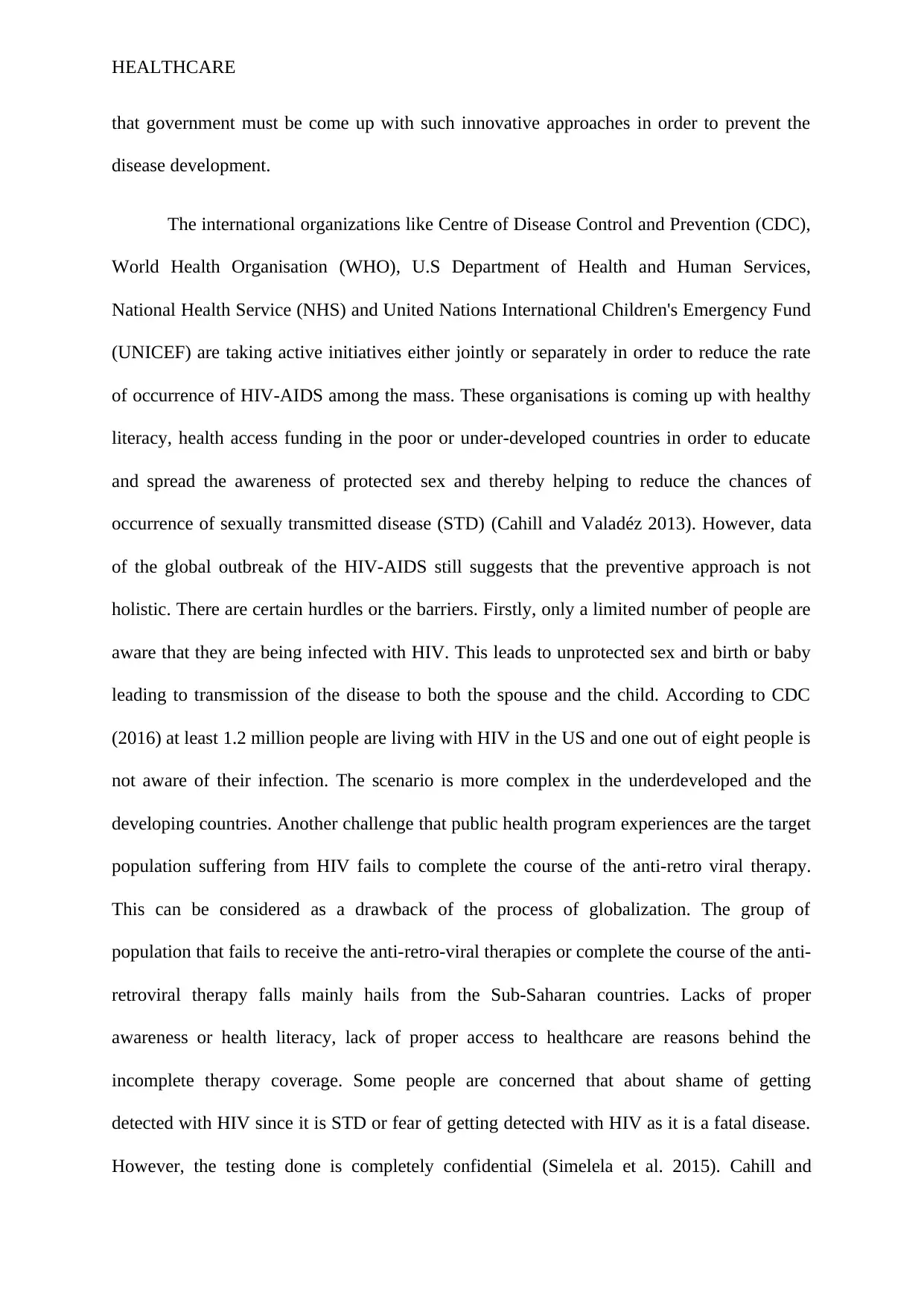
HEALTHCARE
that government must be come up with such innovative approaches in order to prevent the
disease development.
The international organizations like Centre of Disease Control and Prevention (CDC),
World Health Organisation (WHO), U.S Department of Health and Human Services,
National Health Service (NHS) and United Nations International Children's Emergency Fund
(UNICEF) are taking active initiatives either jointly or separately in order to reduce the rate
of occurrence of HIV-AIDS among the mass. These organisations is coming up with healthy
literacy, health access funding in the poor or under-developed countries in order to educate
and spread the awareness of protected sex and thereby helping to reduce the chances of
occurrence of sexually transmitted disease (STD) (Cahill and Valadéz 2013). However, data
of the global outbreak of the HIV-AIDS still suggests that the preventive approach is not
holistic. There are certain hurdles or the barriers. Firstly, only a limited number of people are
aware that they are being infected with HIV. This leads to unprotected sex and birth or baby
leading to transmission of the disease to both the spouse and the child. According to CDC
(2016) at least 1.2 million people are living with HIV in the US and one out of eight people is
not aware of their infection. The scenario is more complex in the underdeveloped and the
developing countries. Another challenge that public health program experiences are the target
population suffering from HIV fails to complete the course of the anti-retro viral therapy.
This can be considered as a drawback of the process of globalization. The group of
population that fails to receive the anti-retro-viral therapies or complete the course of the anti-
retroviral therapy falls mainly hails from the Sub-Saharan countries. Lacks of proper
awareness or health literacy, lack of proper access to healthcare are reasons behind the
incomplete therapy coverage. Some people are concerned that about shame of getting
detected with HIV since it is STD or fear of getting detected with HIV as it is a fatal disease.
However, the testing done is completely confidential (Simelela et al. 2015). Cahill and
that government must be come up with such innovative approaches in order to prevent the
disease development.
The international organizations like Centre of Disease Control and Prevention (CDC),
World Health Organisation (WHO), U.S Department of Health and Human Services,
National Health Service (NHS) and United Nations International Children's Emergency Fund
(UNICEF) are taking active initiatives either jointly or separately in order to reduce the rate
of occurrence of HIV-AIDS among the mass. These organisations is coming up with healthy
literacy, health access funding in the poor or under-developed countries in order to educate
and spread the awareness of protected sex and thereby helping to reduce the chances of
occurrence of sexually transmitted disease (STD) (Cahill and Valadéz 2013). However, data
of the global outbreak of the HIV-AIDS still suggests that the preventive approach is not
holistic. There are certain hurdles or the barriers. Firstly, only a limited number of people are
aware that they are being infected with HIV. This leads to unprotected sex and birth or baby
leading to transmission of the disease to both the spouse and the child. According to CDC
(2016) at least 1.2 million people are living with HIV in the US and one out of eight people is
not aware of their infection. The scenario is more complex in the underdeveloped and the
developing countries. Another challenge that public health program experiences are the target
population suffering from HIV fails to complete the course of the anti-retro viral therapy.
This can be considered as a drawback of the process of globalization. The group of
population that fails to receive the anti-retro-viral therapies or complete the course of the anti-
retroviral therapy falls mainly hails from the Sub-Saharan countries. Lacks of proper
awareness or health literacy, lack of proper access to healthcare are reasons behind the
incomplete therapy coverage. Some people are concerned that about shame of getting
detected with HIV since it is STD or fear of getting detected with HIV as it is a fatal disease.
However, the testing done is completely confidential (Simelela et al. 2015). Cahill and
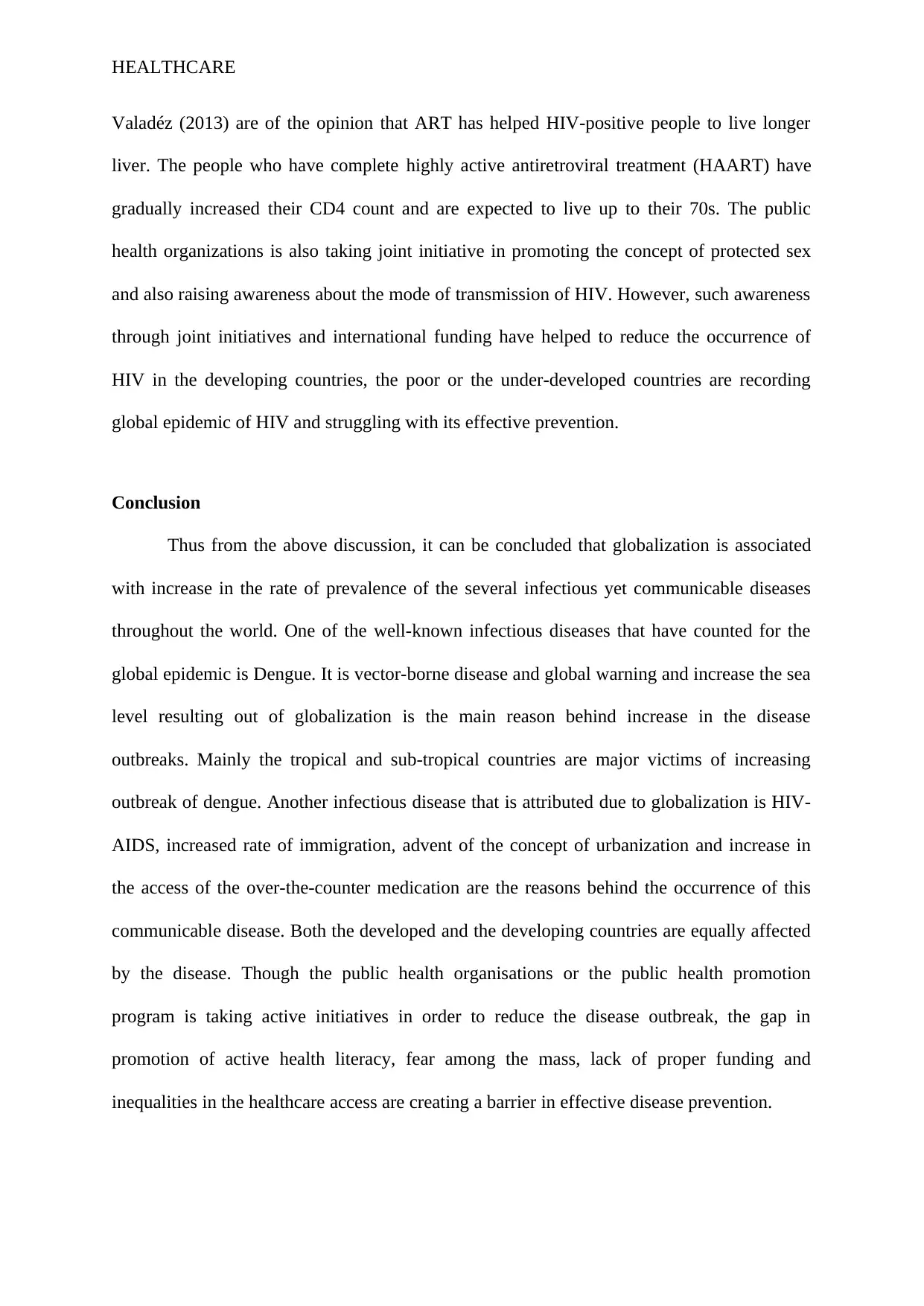
HEALTHCARE
Valadéz (2013) are of the opinion that ART has helped HIV-positive people to live longer
liver. The people who have complete highly active antiretroviral treatment (HAART) have
gradually increased their CD4 count and are expected to live up to their 70s. The public
health organizations is also taking joint initiative in promoting the concept of protected sex
and also raising awareness about the mode of transmission of HIV. However, such awareness
through joint initiatives and international funding have helped to reduce the occurrence of
HIV in the developing countries, the poor or the under-developed countries are recording
global epidemic of HIV and struggling with its effective prevention.
Conclusion
Thus from the above discussion, it can be concluded that globalization is associated
with increase in the rate of prevalence of the several infectious yet communicable diseases
throughout the world. One of the well-known infectious diseases that have counted for the
global epidemic is Dengue. It is vector-borne disease and global warning and increase the sea
level resulting out of globalization is the main reason behind increase in the disease
outbreaks. Mainly the tropical and sub-tropical countries are major victims of increasing
outbreak of dengue. Another infectious disease that is attributed due to globalization is HIV-
AIDS, increased rate of immigration, advent of the concept of urbanization and increase in
the access of the over-the-counter medication are the reasons behind the occurrence of this
communicable disease. Both the developed and the developing countries are equally affected
by the disease. Though the public health organisations or the public health promotion
program is taking active initiatives in order to reduce the disease outbreak, the gap in
promotion of active health literacy, fear among the mass, lack of proper funding and
inequalities in the healthcare access are creating a barrier in effective disease prevention.
Valadéz (2013) are of the opinion that ART has helped HIV-positive people to live longer
liver. The people who have complete highly active antiretroviral treatment (HAART) have
gradually increased their CD4 count and are expected to live up to their 70s. The public
health organizations is also taking joint initiative in promoting the concept of protected sex
and also raising awareness about the mode of transmission of HIV. However, such awareness
through joint initiatives and international funding have helped to reduce the occurrence of
HIV in the developing countries, the poor or the under-developed countries are recording
global epidemic of HIV and struggling with its effective prevention.
Conclusion
Thus from the above discussion, it can be concluded that globalization is associated
with increase in the rate of prevalence of the several infectious yet communicable diseases
throughout the world. One of the well-known infectious diseases that have counted for the
global epidemic is Dengue. It is vector-borne disease and global warning and increase the sea
level resulting out of globalization is the main reason behind increase in the disease
outbreaks. Mainly the tropical and sub-tropical countries are major victims of increasing
outbreak of dengue. Another infectious disease that is attributed due to globalization is HIV-
AIDS, increased rate of immigration, advent of the concept of urbanization and increase in
the access of the over-the-counter medication are the reasons behind the occurrence of this
communicable disease. Both the developed and the developing countries are equally affected
by the disease. Though the public health organisations or the public health promotion
program is taking active initiatives in order to reduce the disease outbreak, the gap in
promotion of active health literacy, fear among the mass, lack of proper funding and
inequalities in the healthcare access are creating a barrier in effective disease prevention.
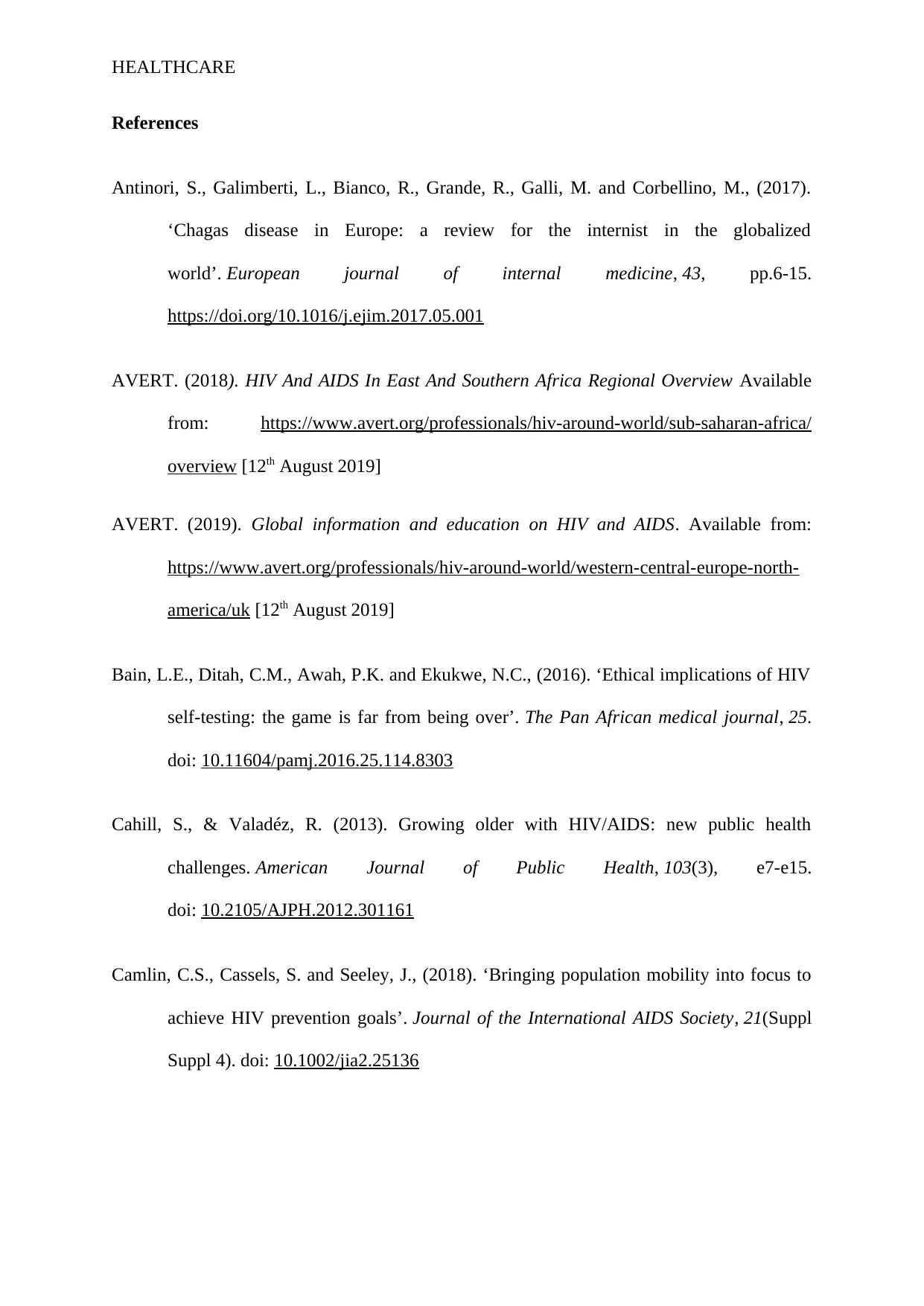
HEALTHCARE
References
Antinori, S., Galimberti, L., Bianco, R., Grande, R., Galli, M. and Corbellino, M., (2017).
‘Chagas disease in Europe: a review for the internist in the globalized
world’. European journal of internal medicine, 43, pp.6-15.
https://doi.org/10.1016/j.ejim.2017.05.001
AVERT. (2018). HIV And AIDS In East And Southern Africa Regional Overview Available
from: https://www.avert.org/professionals/hiv-around-world/sub-saharan-africa/
overview [12th August 2019]
AVERT. (2019). Global information and education on HIV and AIDS. Available from:
https://www.avert.org/professionals/hiv-around-world/western-central-europe-north-
america/uk [12th August 2019]
Bain, L.E., Ditah, C.M., Awah, P.K. and Ekukwe, N.C., (2016). ‘Ethical implications of HIV
self-testing: the game is far from being over’. The Pan African medical journal, 25.
doi: 10.11604/pamj.2016.25.114.8303
Cahill, S., & Valadéz, R. (2013). Growing older with HIV/AIDS: new public health
challenges. American Journal of Public Health, 103(3), e7-e15.
doi: 10.2105/AJPH.2012.301161
Camlin, C.S., Cassels, S. and Seeley, J., (2018). ‘Bringing population mobility into focus to
achieve HIV prevention goals’. Journal of the International AIDS Society, 21(Suppl
Suppl 4). doi: 10.1002/jia2.25136
References
Antinori, S., Galimberti, L., Bianco, R., Grande, R., Galli, M. and Corbellino, M., (2017).
‘Chagas disease in Europe: a review for the internist in the globalized
world’. European journal of internal medicine, 43, pp.6-15.
https://doi.org/10.1016/j.ejim.2017.05.001
AVERT. (2018). HIV And AIDS In East And Southern Africa Regional Overview Available
from: https://www.avert.org/professionals/hiv-around-world/sub-saharan-africa/
overview [12th August 2019]
AVERT. (2019). Global information and education on HIV and AIDS. Available from:
https://www.avert.org/professionals/hiv-around-world/western-central-europe-north-
america/uk [12th August 2019]
Bain, L.E., Ditah, C.M., Awah, P.K. and Ekukwe, N.C., (2016). ‘Ethical implications of HIV
self-testing: the game is far from being over’. The Pan African medical journal, 25.
doi: 10.11604/pamj.2016.25.114.8303
Cahill, S., & Valadéz, R. (2013). Growing older with HIV/AIDS: new public health
challenges. American Journal of Public Health, 103(3), e7-e15.
doi: 10.2105/AJPH.2012.301161
Camlin, C.S., Cassels, S. and Seeley, J., (2018). ‘Bringing population mobility into focus to
achieve HIV prevention goals’. Journal of the International AIDS Society, 21(Suppl
Suppl 4). doi: 10.1002/jia2.25136
Paraphrase This Document
Need a fresh take? Get an instant paraphrase of this document with our AI Paraphraser
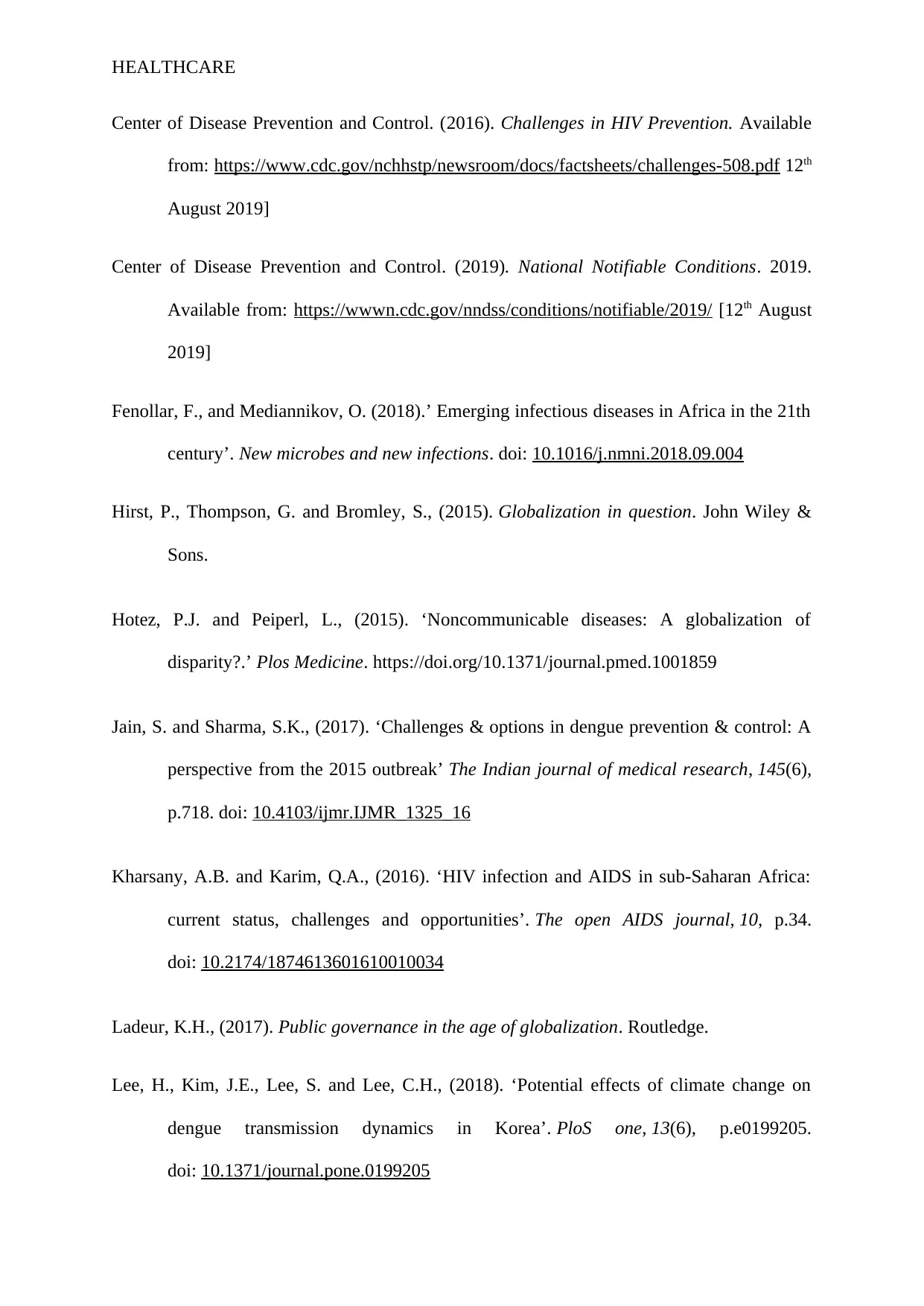
HEALTHCARE
Center of Disease Prevention and Control. (2016). Challenges in HIV Prevention. Available
from: https://www.cdc.gov/nchhstp/newsroom/docs/factsheets/challenges-508.pdf 12th
August 2019]
Center of Disease Prevention and Control. (2019). National Notifiable Conditions. 2019.
Available from: https://wwwn.cdc.gov/nndss/conditions/notifiable/2019/ [12th August
2019]
Fenollar, F., and Mediannikov, O. (2018).’ Emerging infectious diseases in Africa in the 21th
century’. New microbes and new infections. doi: 10.1016/j.nmni.2018.09.004
Hirst, P., Thompson, G. and Bromley, S., (2015). Globalization in question. John Wiley &
Sons.
Hotez, P.J. and Peiperl, L., (2015). ‘Noncommunicable diseases: A globalization of
disparity?.’ Plos Medicine. https://doi.org/10.1371/journal.pmed.1001859
Jain, S. and Sharma, S.K., (2017). ‘Challenges & options in dengue prevention & control: A
perspective from the 2015 outbreak’ The Indian journal of medical research, 145(6),
p.718. doi: 10.4103/ijmr.IJMR_1325_16
Kharsany, A.B. and Karim, Q.A., (2016). ‘HIV infection and AIDS in sub-Saharan Africa:
current status, challenges and opportunities’. The open AIDS journal, 10, p.34.
doi: 10.2174/1874613601610010034
Ladeur, K.H., (2017). Public governance in the age of globalization. Routledge.
Lee, H., Kim, J.E., Lee, S. and Lee, C.H., (2018). ‘Potential effects of climate change on
dengue transmission dynamics in Korea’. PloS one, 13(6), p.e0199205.
doi: 10.1371/journal.pone.0199205
Center of Disease Prevention and Control. (2016). Challenges in HIV Prevention. Available
from: https://www.cdc.gov/nchhstp/newsroom/docs/factsheets/challenges-508.pdf 12th
August 2019]
Center of Disease Prevention and Control. (2019). National Notifiable Conditions. 2019.
Available from: https://wwwn.cdc.gov/nndss/conditions/notifiable/2019/ [12th August
2019]
Fenollar, F., and Mediannikov, O. (2018).’ Emerging infectious diseases in Africa in the 21th
century’. New microbes and new infections. doi: 10.1016/j.nmni.2018.09.004
Hirst, P., Thompson, G. and Bromley, S., (2015). Globalization in question. John Wiley &
Sons.
Hotez, P.J. and Peiperl, L., (2015). ‘Noncommunicable diseases: A globalization of
disparity?.’ Plos Medicine. https://doi.org/10.1371/journal.pmed.1001859
Jain, S. and Sharma, S.K., (2017). ‘Challenges & options in dengue prevention & control: A
perspective from the 2015 outbreak’ The Indian journal of medical research, 145(6),
p.718. doi: 10.4103/ijmr.IJMR_1325_16
Kharsany, A.B. and Karim, Q.A., (2016). ‘HIV infection and AIDS in sub-Saharan Africa:
current status, challenges and opportunities’. The open AIDS journal, 10, p.34.
doi: 10.2174/1874613601610010034
Ladeur, K.H., (2017). Public governance in the age of globalization. Routledge.
Lee, H., Kim, J.E., Lee, S. and Lee, C.H., (2018). ‘Potential effects of climate change on
dengue transmission dynamics in Korea’. PloS one, 13(6), p.e0199205.
doi: 10.1371/journal.pone.0199205
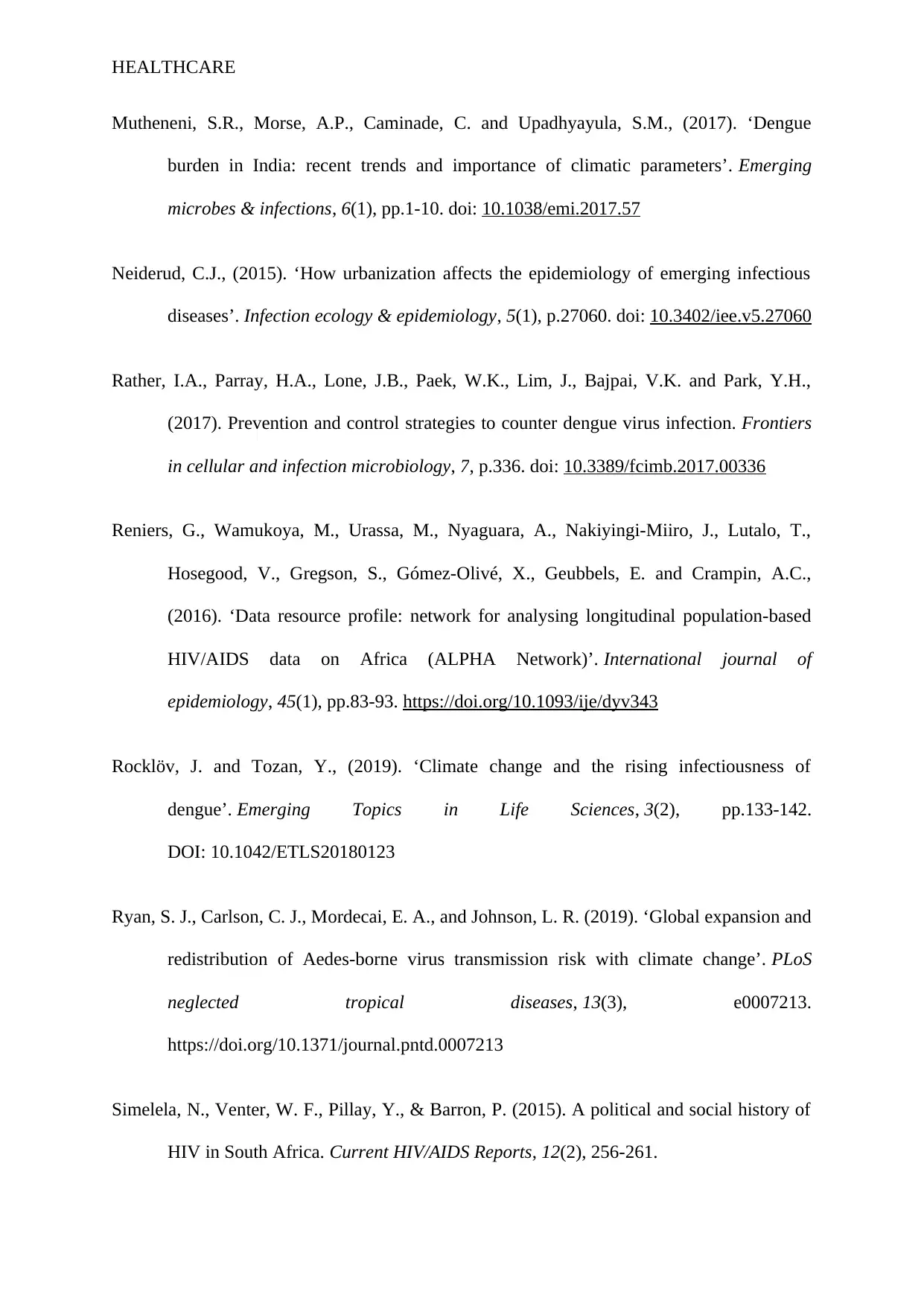
HEALTHCARE
Mutheneni, S.R., Morse, A.P., Caminade, C. and Upadhyayula, S.M., (2017). ‘Dengue
burden in India: recent trends and importance of climatic parameters’. Emerging
microbes & infections, 6(1), pp.1-10. doi: 10.1038/emi.2017.57
Neiderud, C.J., (2015). ‘How urbanization affects the epidemiology of emerging infectious
diseases’. Infection ecology & epidemiology, 5(1), p.27060. doi: 10.3402/iee.v5.27060
Rather, I.A., Parray, H.A., Lone, J.B., Paek, W.K., Lim, J., Bajpai, V.K. and Park, Y.H.,
(2017). Prevention and control strategies to counter dengue virus infection. Frontiers
in cellular and infection microbiology, 7, p.336. doi: 10.3389/fcimb.2017.00336
Reniers, G., Wamukoya, M., Urassa, M., Nyaguara, A., Nakiyingi-Miiro, J., Lutalo, T.,
Hosegood, V., Gregson, S., Gómez-Olivé, X., Geubbels, E. and Crampin, A.C.,
(2016). ‘Data resource profile: network for analysing longitudinal population-based
HIV/AIDS data on Africa (ALPHA Network)’. International journal of
epidemiology, 45(1), pp.83-93. https://doi.org/10.1093/ije/dyv343
Rocklöv, J. and Tozan, Y., (2019). ‘Climate change and the rising infectiousness of
dengue’. Emerging Topics in Life Sciences, 3(2), pp.133-142.
DOI: 10.1042/ETLS20180123
Ryan, S. J., Carlson, C. J., Mordecai, E. A., and Johnson, L. R. (2019). ‘Global expansion and
redistribution of Aedes-borne virus transmission risk with climate change’. PLoS
neglected tropical diseases, 13(3), e0007213.
https://doi.org/10.1371/journal.pntd.0007213
Simelela, N., Venter, W. F., Pillay, Y., & Barron, P. (2015). A political and social history of
HIV in South Africa. Current HIV/AIDS Reports, 12(2), 256-261.
Mutheneni, S.R., Morse, A.P., Caminade, C. and Upadhyayula, S.M., (2017). ‘Dengue
burden in India: recent trends and importance of climatic parameters’. Emerging
microbes & infections, 6(1), pp.1-10. doi: 10.1038/emi.2017.57
Neiderud, C.J., (2015). ‘How urbanization affects the epidemiology of emerging infectious
diseases’. Infection ecology & epidemiology, 5(1), p.27060. doi: 10.3402/iee.v5.27060
Rather, I.A., Parray, H.A., Lone, J.B., Paek, W.K., Lim, J., Bajpai, V.K. and Park, Y.H.,
(2017). Prevention and control strategies to counter dengue virus infection. Frontiers
in cellular and infection microbiology, 7, p.336. doi: 10.3389/fcimb.2017.00336
Reniers, G., Wamukoya, M., Urassa, M., Nyaguara, A., Nakiyingi-Miiro, J., Lutalo, T.,
Hosegood, V., Gregson, S., Gómez-Olivé, X., Geubbels, E. and Crampin, A.C.,
(2016). ‘Data resource profile: network for analysing longitudinal population-based
HIV/AIDS data on Africa (ALPHA Network)’. International journal of
epidemiology, 45(1), pp.83-93. https://doi.org/10.1093/ije/dyv343
Rocklöv, J. and Tozan, Y., (2019). ‘Climate change and the rising infectiousness of
dengue’. Emerging Topics in Life Sciences, 3(2), pp.133-142.
DOI: 10.1042/ETLS20180123
Ryan, S. J., Carlson, C. J., Mordecai, E. A., and Johnson, L. R. (2019). ‘Global expansion and
redistribution of Aedes-borne virus transmission risk with climate change’. PLoS
neglected tropical diseases, 13(3), e0007213.
https://doi.org/10.1371/journal.pntd.0007213
Simelela, N., Venter, W. F., Pillay, Y., & Barron, P. (2015). A political and social history of
HIV in South Africa. Current HIV/AIDS Reports, 12(2), 256-261.
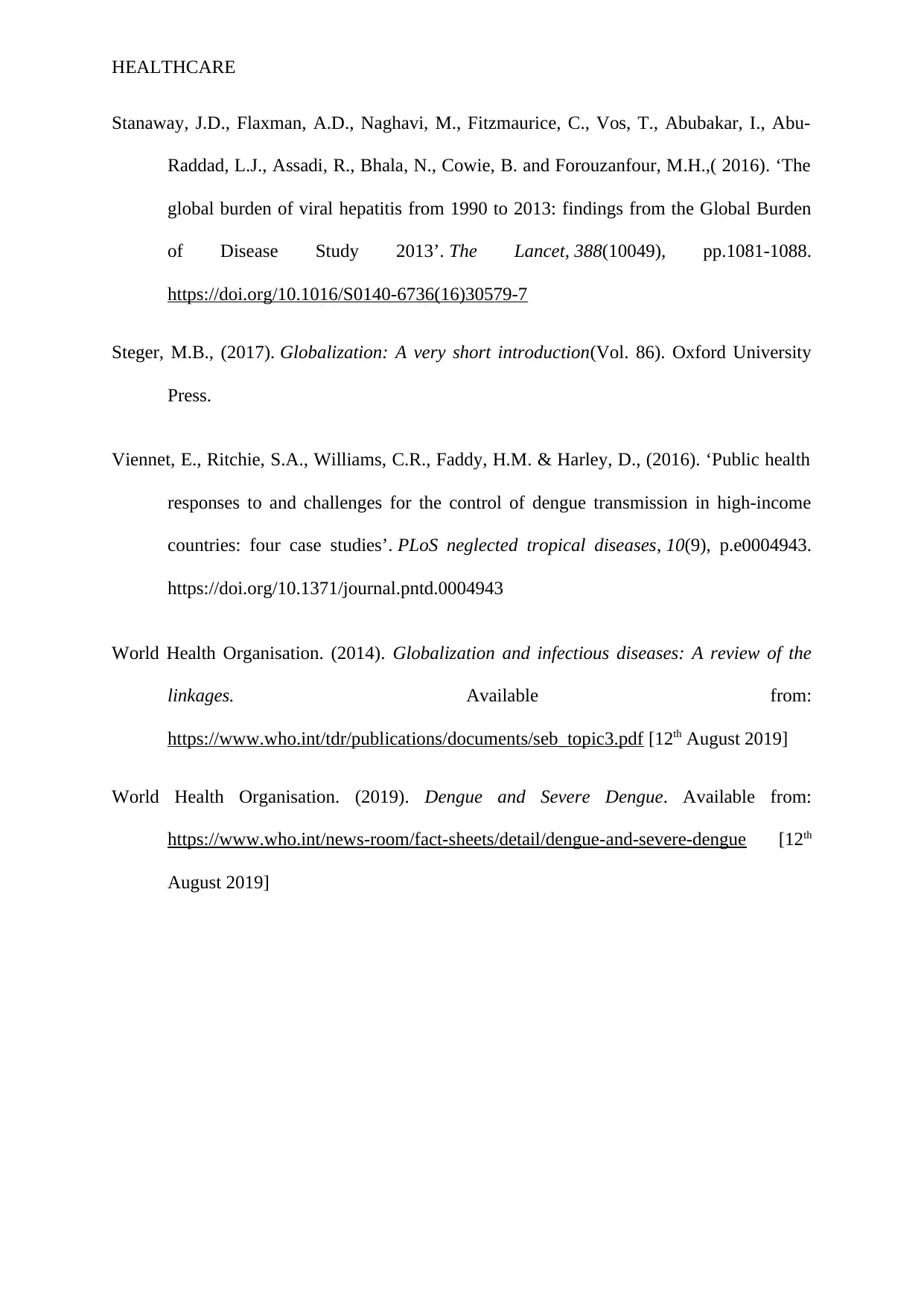
HEALTHCARE
Stanaway, J.D., Flaxman, A.D., Naghavi, M., Fitzmaurice, C., Vos, T., Abubakar, I., Abu-
Raddad, L.J., Assadi, R., Bhala, N., Cowie, B. and Forouzanfour, M.H.,( 2016). ‘The
global burden of viral hepatitis from 1990 to 2013: findings from the Global Burden
of Disease Study 2013’. The Lancet, 388(10049), pp.1081-1088.
https://doi.org/10.1016/S0140-6736(16)30579-7
Steger, M.B., (2017). Globalization: A very short introduction(Vol. 86). Oxford University
Press.
Viennet, E., Ritchie, S.A., Williams, C.R., Faddy, H.M. & Harley, D., (2016). ‘Public health
responses to and challenges for the control of dengue transmission in high-income
countries: four case studies’. PLoS neglected tropical diseases, 10(9), p.e0004943.
https://doi.org/10.1371/journal.pntd.0004943
World Health Organisation. (2014). Globalization and infectious diseases: A review of the
linkages. Available from:
https://www.who.int/tdr/publications/documents/seb_topic3.pdf [12th August 2019]
World Health Organisation. (2019). Dengue and Severe Dengue. Available from:
https://www.who.int/news-room/fact-sheets/detail/dengue-and-severe-dengue [12th
August 2019]
Stanaway, J.D., Flaxman, A.D., Naghavi, M., Fitzmaurice, C., Vos, T., Abubakar, I., Abu-
Raddad, L.J., Assadi, R., Bhala, N., Cowie, B. and Forouzanfour, M.H.,( 2016). ‘The
global burden of viral hepatitis from 1990 to 2013: findings from the Global Burden
of Disease Study 2013’. The Lancet, 388(10049), pp.1081-1088.
https://doi.org/10.1016/S0140-6736(16)30579-7
Steger, M.B., (2017). Globalization: A very short introduction(Vol. 86). Oxford University
Press.
Viennet, E., Ritchie, S.A., Williams, C.R., Faddy, H.M. & Harley, D., (2016). ‘Public health
responses to and challenges for the control of dengue transmission in high-income
countries: four case studies’. PLoS neglected tropical diseases, 10(9), p.e0004943.
https://doi.org/10.1371/journal.pntd.0004943
World Health Organisation. (2014). Globalization and infectious diseases: A review of the
linkages. Available from:
https://www.who.int/tdr/publications/documents/seb_topic3.pdf [12th August 2019]
World Health Organisation. (2019). Dengue and Severe Dengue. Available from:
https://www.who.int/news-room/fact-sheets/detail/dengue-and-severe-dengue [12th
August 2019]
Secure Best Marks with AI Grader
Need help grading? Try our AI Grader for instant feedback on your assignments.

HEALTHCARE
1 out of 17
Related Documents
Your All-in-One AI-Powered Toolkit for Academic Success.
+13062052269
info@desklib.com
Available 24*7 on WhatsApp / Email
![[object Object]](/_next/static/media/star-bottom.7253800d.svg)
Unlock your academic potential
© 2024 | Zucol Services PVT LTD | All rights reserved.





